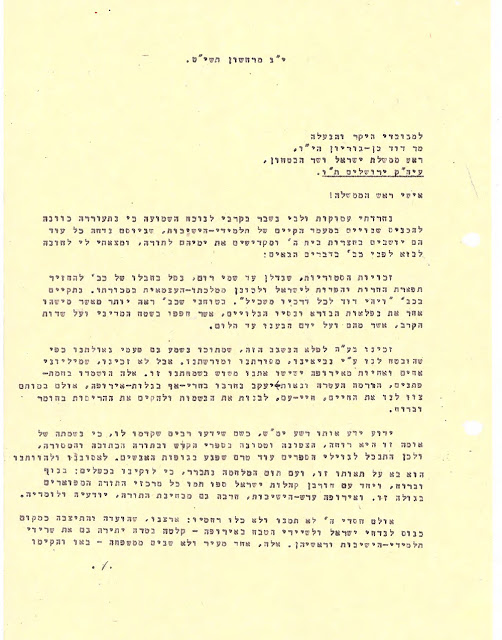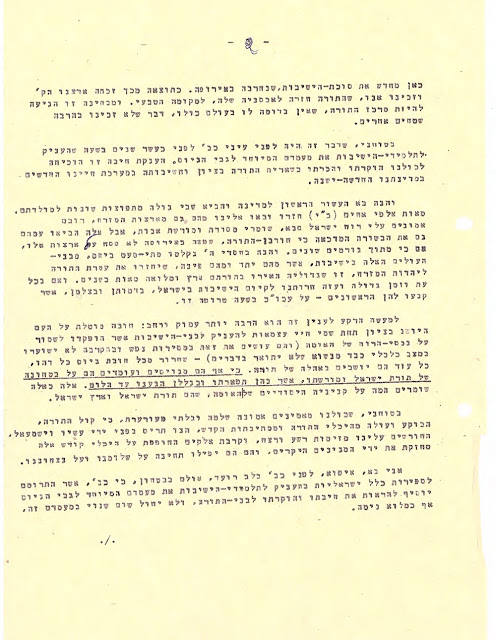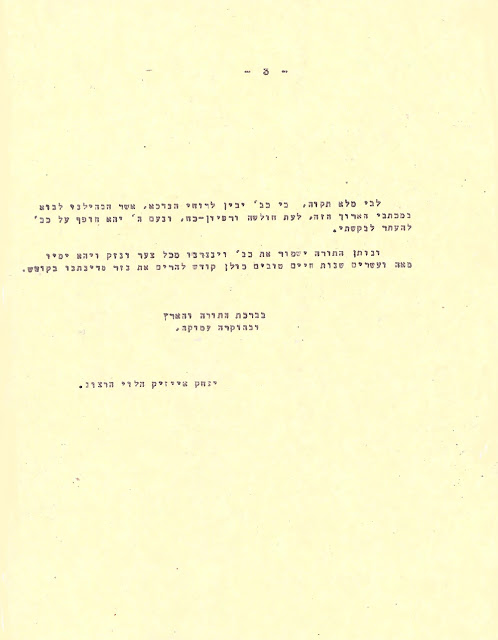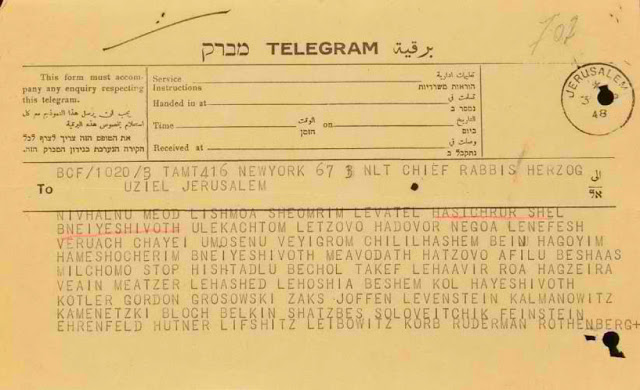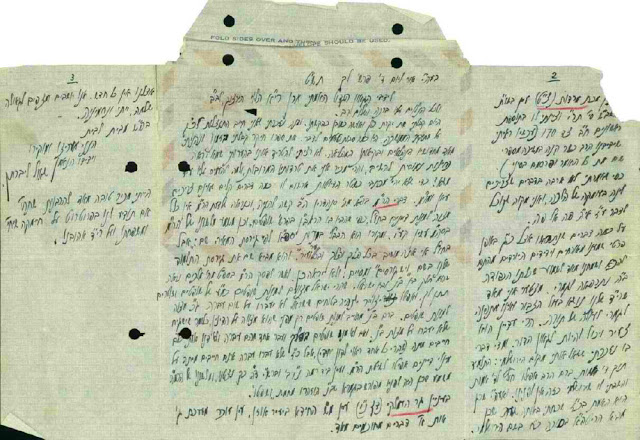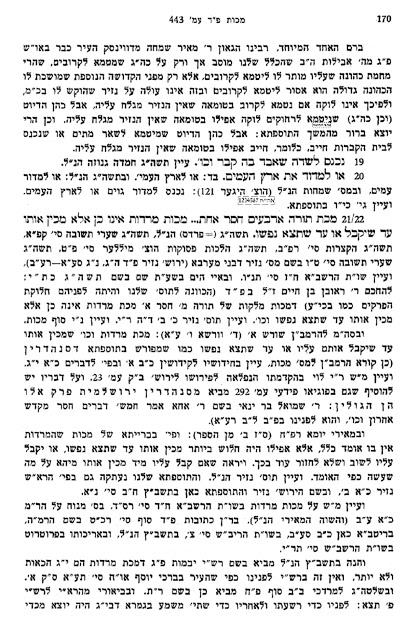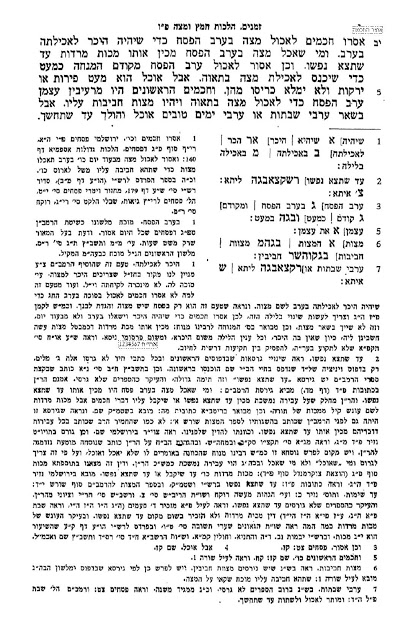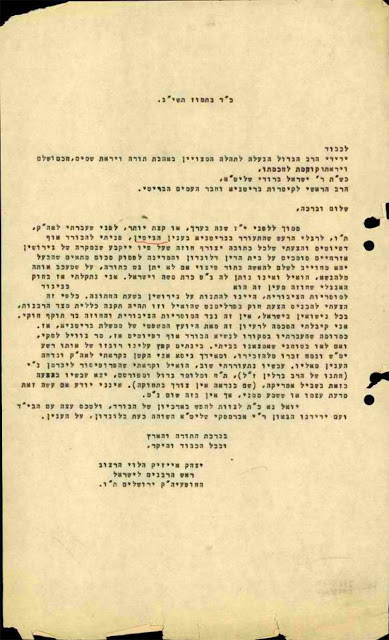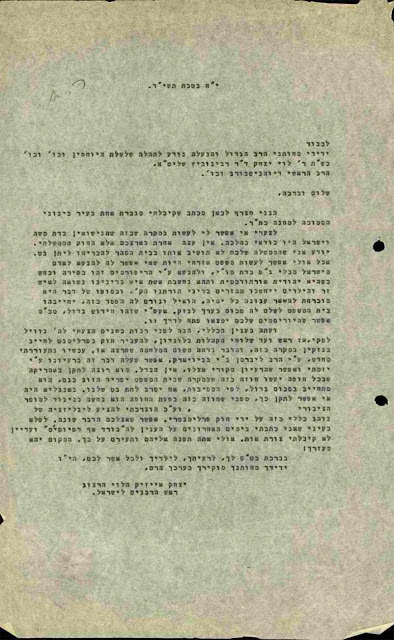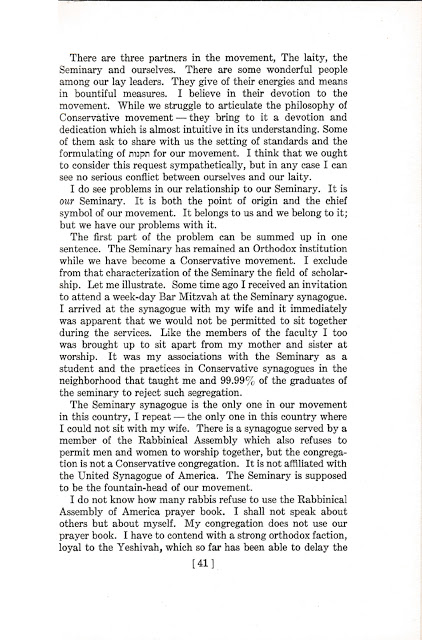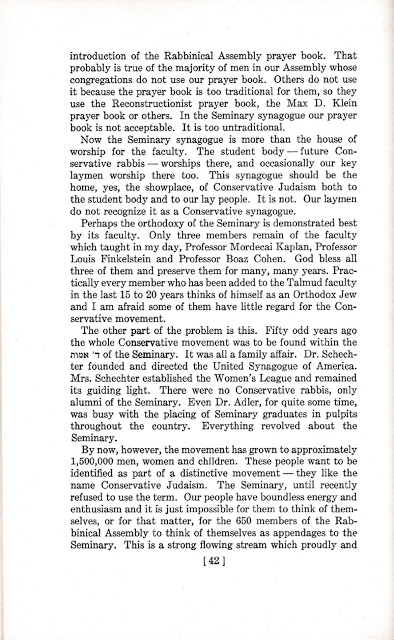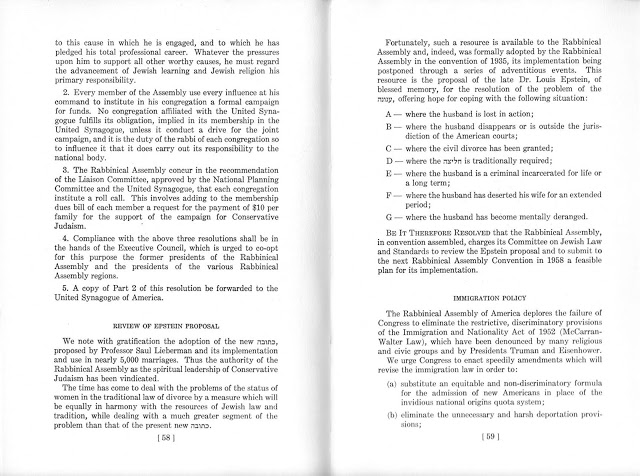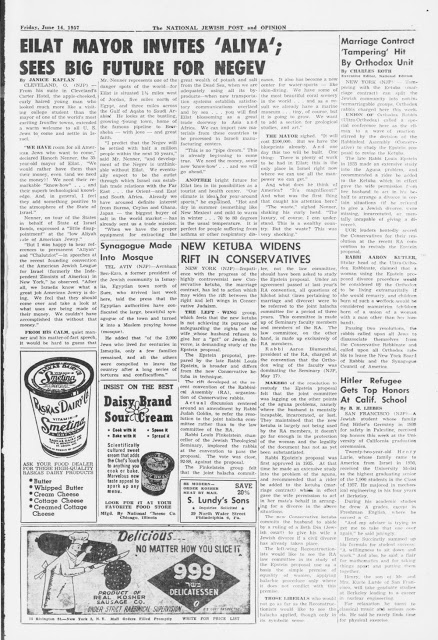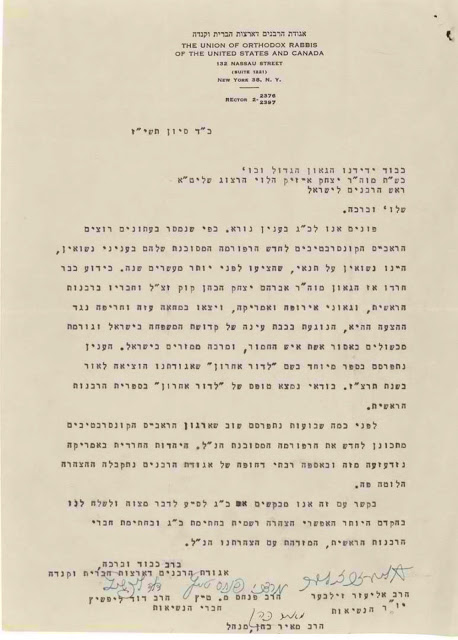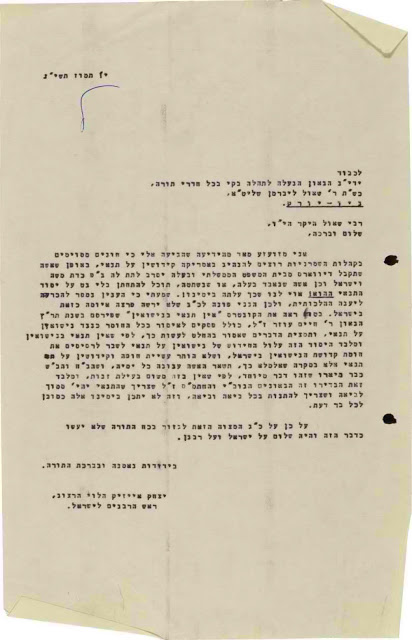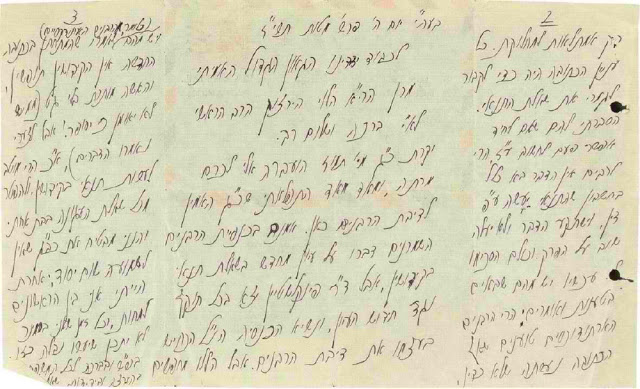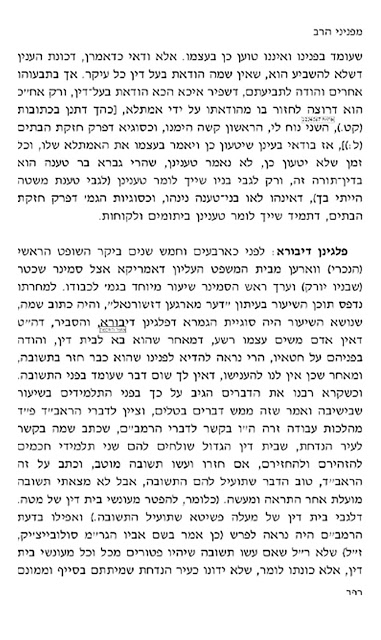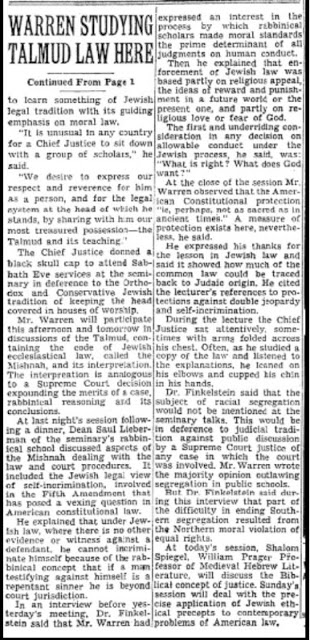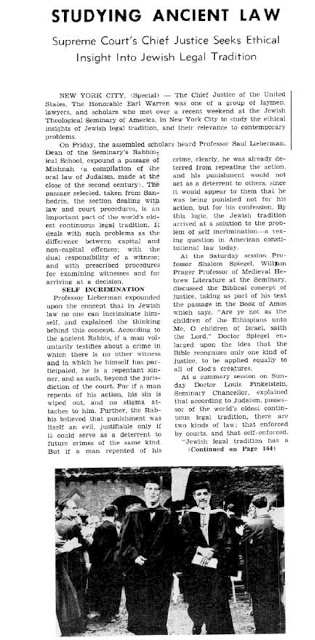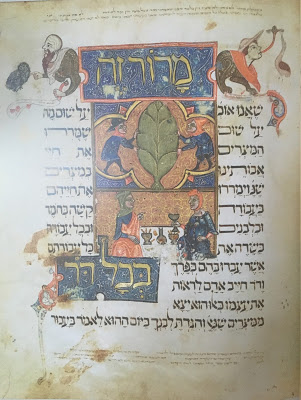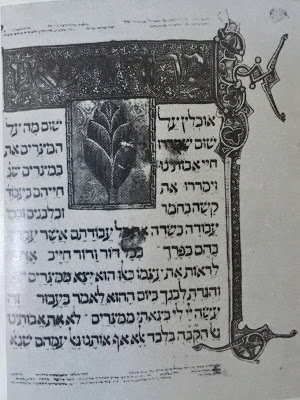The Not-So-Humble Artichoke in Ancient Jewish Sources
Not-So-Humble Artichoke in Ancient Jewish Sources
Weingarten
Susan
Weingarten is an archaeologist and food historian living in
Jerusalem. This is an adapted extract from her paper ‘The
Rabbi and the Emperors: Artichokes and Cucumbers as Symbols of Status
in Talmudic Literature,’
in
When
West met East: the Encounter of Greece and Rome with the Jews,
Egyptians and Others: Studies presented to Ranon Katzoff on his 75th
Birthday.
Edited
by
D.
Schaps, U. Yiftach and D. Dueck.
(Trieste,
2016).
has been a lot of discussion of artichokes recently in the wake of
the ruling by the Israeli Rabbinate that they are not kosher. A
recent post on Seforim Blog traced their ancestry as a Jewish food
back to the 14th
century.
But we can go back further, to the talmudic literature, where
artichokes appear as qinras.
We
can identify many Greek (and fewer Latin) food-names in the Aramaic
and Hebrew of the written texts of the talmudic literature. The
rabbis sometimes use Greek terminology to explain food names. Thus,
for example, biblical regulations on agriculture include a ban on
growing two different kinds of crops together. Mishnah Kilayim
tells
us that thistles (qotzim)
are allowed in a vineyard, i.e. they are seen as wild growths, but
artichokes (qinras)
are not allowed, so that it is clear that artichokes are seen as
cultivated rather than wild growths.[1] Qotz,
the wild thistle, is a biblical Hebrew term, while the Aramaic qinras
appears
to be derived from the Greek for artichoke,
kinara
or
kynara.
Artichokes
were carefully cultivated in the Graeco-Roman world; presumably their
name came with the agricultural methods which turned wild thistles
into cultivated artichokes. It is still difficult to know whether the
artichoke proper is meant here, or rather the closely related
cardoon.[2] It is clear, however, that there were a number of edible
thistles which grew wild, and that the artichoke is a cultivated
variety. The medical writer Galen describes the artichoke as
‘overvalued.’[3] This was partly because of its negative health
properties, for he saw it as unwholesome, sometimes hard and woody,
with bitter juice. So he recommends boiling artichokes and adding
coriander if eating them with oil and garum;[4]
or frying them in a pan.
Galen’s objections to artichokes may not be merely medical. They
may also be an echo of the attitude we find in Pliny,[5] who tells us
that artichokes were exceptionally prized by the gourmets of Rome,
and that there was a roaring trade in them. Pliny disapproved:
‘There
still remains an extremely profitable article of trade which must be
mentioned, not without a feeling of shame. The fact is that it is
well-known that at Carthage, and particularly at Cordoba, crops of
carduos,
artichokes,
yield
a return of 6000 sesterces from small plots – since we turn even
the monstrosities of the earth to purposes of gluttony … they are
conserved in honey-vinegar with silphium and cumin, so that there
should be no day without thistles for dinner.[6]
writing in the first century, uses all the tricks of rhetoric to put
over his disapproval of this ridiculous fad of over-valuing
artichokes, and eating them out of season: note the alliteration and
assonance of carduos
with
Cartago and Corduba, which he presumably despised as far-away
provincial cities.[7] He is also indignant about the enormous prices
charged for them, satirising the rich who eat the artichokes as being
lower than the animals who despise them.[8] His diatribe does not
seem to have been generally successful. Artichokes were still clearly
prized in the Roman world of the third and fourth centuries: a mosaic
from the so-called ‘House of the Buffet Supper’ in Antioch shows
them on a silver tray as a first course for dinner.[9] And in a
Palestinian context, another mosaic with what look like two purplish
artichoke heads and a silver bowl, dated to the third century, has
been found recently in excavations of ancient Jerusalem – or rather
Aelia
Capitolina.[10]
classical picture of artichokes as food for the rich and upper
classes is confirmed by the talmudic literature. For example, Midrash
Esther Rabbah, writes:
‘Bar
Yohania made a feast for the notables of Rome … What was missing?
Only the qinras
(=artichoke).’[11]
Klein in his article ‘Bar-Yohannis from Sepphoris at Rome,’
suggested
that this may be the first reference to the famous Roman Jewish
artichoke dish carciofi
alla giudia.[12]
(For a recipe see E. Servi Machlin The
Classic Cuisine of the Italian Jews
[NY,1981,
1993] p. 180-1). Unfortunately there is no proof to confirm Klein’s
charming suggestion, since, as we have seen, artichokes seem to have
been famously popular among the Roman pagan nobility.[3] One of the
reasons for the perceived desirability of artichokes as food may also
have been the effort needed to prepare them – an effort usually
only available to the rich through their slaves – the poor would
have had little time for this. But one time when the poorer Jews
would have had time would be on a festival, when ordinary work was
not allowed, but food-preparation was permitted, as it contributed to
the enjoyment of the festival. The Tosefta specifically states that
while cutting vegetables was generally not allowed on a festival (in
case people actually went and cut them down in the fields), trimming
artichokes and ‘akavit/‘aqubit,
a wild thorny plant, was allowed, as this was part of the preparation
needed for cooking these prickly vegetables, which was allowed on a
festival:
‘[On
a festival] they do not cut vegetables with shears but they do trim
the qinras,
artichoke,
and the‘akavit/‘aqubit.’[14]
poorer people actually ate artichokes as special festival food, or
rather only ate the wild ‘akavit/‘aqubit
is
unclear from this source. It is also unclear what the reason for
trimming was: to remove the thorny stems or to cut off the upper part
of the leaves and remove the inedible inner part known as the
‘choke’?
Babylonian Talmud records that artichokes were sent over long
distances to be eaten by Rabbi Judah haNasi. A rich man called Bonias
‘sent Rabbi a measure of artichokes from Nawsah, and Rabbi
estimated it at two hundred and seventeen eggs.’[15] The eggs here
are a measure of volume: clearly there were quite a lot of
artichokes. ‘Nawsah’ may refer to a settlement on an island in
the Euphrates River outside Babylonia.[16] It was a long way from
Galilee where Rabbi lived, and only the rich could afford to pay for
the transport of these luxuries. Some way of preserving the
artichokes, like keeping them in honey-vinegar as described by Pliny
above, must have been used.
the classical sources, there is no moral condemnation here of
artichokes as symbols of conspicuous consumption, and tampering with
nature. The rabbis of the Talmudim are generally presented as
appreciative of good food, and as seeing feasting as desirable,
rather than to be condemned.[17] Eating good food, for example, is
one of the recommended ways of celebrating or ‘honouring’ Sabbath
and festival.[18] Indeed, Rabbi himself, when looking back
nostalgically to the time when the Temple still stood, represented
his longing for it in terms of desire for the wonderful foods that
would have been available in that now legendary time.[19]
did Rabbi eat his cucumbers and artichokes? Unfortunately the
talmudic literature does not tell us, but there are details in some
Roman authors which may give us some idea of the possibilities.
Athenaeus tells us artichokes must be well-seasoned, or they will be
inedible. The fourth-century Roman cookery book attributed to Apicius
recommends serving artichokes with liquamen
and
oil, and either chopped boiled egg; or cumin and pepper; or pounded
green herbs with pepper and honey.[20] We have already cited Rabbi’s
contemporary, the medical writer Galen, who visited Syria and other
parts of the Near East. He sometimes describes methods of cooking
similar to those found in the talmudic literature.[21] We saw that
Galen recommends eating artichokes boiled with the addition of
coriander, garum
and
oil. He also mentions frying them. Was this the origin of carciofi
alla giudia?
Mishnah Kilayim v 8.
The identification of the Latin term cardui
with
artichokes, rather than cardoons, has recently been questioned:C.A.
Wright ‘Did the ancients know the artichoke?’
Gastronomica
9/4
(2009) 21-27.
Galen On
the powers of foods ii.
Garum
was
the famous Graeco-Roman salty fermented fish-sauce, called liquamen
by
Apicius, used widely as a condiment. R.I. Curtis Garum
and salsamenta: production and commerce in materia medica (Leiden,
1991); M. Grant Roman
Cookery
(London,
1999); S. Grainger, C.Grocock Apicius:
a critical edition,
(Totnes, 2006)373-387:
Appendix
4: Excursus on garum and liquamen.
It is found in the talmudic literature under the name of muries:
S. Weingarten ‘Mouldy bread and rotten fish: delicacies in the
ancient world,’ Food
and History
3
(2005) 61-72. Sauces combined with garum are mentioned in eg Tos
Betsah ii, 16 and in BTYoma76a, but it is not clear that Babylonian
Jews were using this term to mean the same foodstuffs as were used by
the Jews of the Land of Israel.
Pliny : NH
19,
152f.
Pliny NH
19,
152-3: certum
est quippe carduos apud Carthaginem magnam Cordubamque praecipue
sestertium sena milia e parvis redderareis, quoniam portent quoque
terrarium in ganeam vertimus, serimusque etiam ea quae refugiunt
cunctae quadrupedes …condiuntur quoque aceto melle diluto addita
laseris radice et cumino, ne quis dies sine carduo sit.
On Pliny’s distrust of the ‘foreign’ taking over the Roman, an
old Roman literary trope, see T. Murphy Pliny
the Elder’s Natural
History:
the empire in the encyclopedia (Oxford,
2004) 68ff.
On Pliny’s hostility to luxury, a traditional theme of Latin
poetry: Murphy (above n.35) 71. See also M. Beagon Roman
Nature: the thought of Pliny the Elder
(Oxford,
1992) 190: ‘moral condemnation of luxuria
is
more than a commonplace to Pliny.’
F. Cimok (ed.) Antioch
Mosaics
(Istanbul,
1995) 44-47.
The mosaic was excavated by Shlomit Wexler-Bdollach and has been
published by Rina Talgam Mosaics
of Faith (Jerusalem/Pennsylvania,
2014) p. 48 fig 70. I am grateful to both for allowing me to see
their pictures and text prior to publication.
The question of whether the midrash is to be seen as referring to a
Persian situation is beyond the scope of this paper.
BJPES
7
(1940) 47-51 (in Hebrew)
See also
I.
Löw Die
Flora
der Juden
vol
I, (Wien, 1924, repr Hildesheim, 1967) p.409.
Tosefta Beitzah [Yom Tov] iii,19 and cf BTBeitzah 34a. ‘Akavit/
‘aqubit
has
been identified with tumbleweed, Gundelia
Tourneforti,
which is a wild edible thistle still eaten in Galilee and Lebanon,
and known by its Arabic name, ‘aqub.
See
A. Shmida Mapa’s
dictionary of plants and flowers in Israel (Tel
Aviv, 2005, in Hebrew) 236; A. Helou ‘An edible wild thistle from
the Lebanese mountains’ in Susan Friedman (ed.) Vegetables:
proceedings of the Oxford Symposium on Food and Cookery 2008 (Totnes,
2009) 83-4. ‘Aqub
can
still be bought in the present-day market in Tiberias in the spring,
its price depending on whether the vendor has removed the thorns or
left that pleasure to the buyer. Its taste when cooked is not unlike
artichoke.
BT Eruvin 83a (my translation).
For the identification of Nawsah see A. Oppenheimer, Babylonia
Judaica in the Talmudic Period
(Wiesbaden,
1983) pp.266-7.
This point about the generally positive attitude of the rabbis (in
this case the Babylonian rabbis) to the good things in life is made
by I.M. Gafni The
Jews of Babylonia in the talmudic era: a social and cultural history
(Jerusalem,
1990) 130 citing M. Beer Amoraei
Bavel – peraqim be-hayei ha-kalkalah
(Ramat
Gan תשל”ה
).
But having made his point, Gafni hedges here, warning against taking
a series of anecdotes from different periods as evidence. However, we
should note that this picture is consistent over both Palestinian and
Babylonian sources, and if we compare it to, say, the attitudes of
early Christian writers or Philo, we see that this trend is absent
there. See my paper ‘Magiros,
nahtom
and
women at home: cooks in the Talmud’ Journal
of Jewish Studies 56
(2005)
285-297.
For a discussion of the rabbinical requirement in both Bavli
and Yerushalmi to honour the Sabbath by eating good food, see S.J.D.
Cohen,’Dancing, clapping, meditating: Jewish and Christian observance
of the Sabbath in pseudo-Ignatius’ in B. Isaac, Y. Shahar (eds)
Judaea-Palaestina,
Babylon and Rome: Jews in Antiquity
(Tübingen,
2012) 33-38.
Midrash Lamentations Rabbah iii, 6/17.
Apicius
3.6.
See e.g. S. Weingarten ‘Eggs in the Talmud’ in R. Hosking
(ed.) Eggs
in Cookery: Proceedings of the Oxford Symposium on Food and Cookery,
2006
(Totnes,
2007) 274-276.
The Humble Artichoke
Jews in Italy, however, took issue with this ruling. They pointed to a long-standing tradition of eating artichokes whole after deep frying. That tradition places the creation of the dish sometime in the 16th century in the Jewish ghetto in Rome. Indeed, their preparation is so intertwined with Jews, in Italian it is called Jewish-style artichoke—Carciofo alla giudia. Today many travel books include this delicacy among those to try in Italy listing various kosher restaurants that offer the Jewish Artichoke. The Rabbi of Rome refused to reform the practice of Italian Jews and continues to eat and provide his hechsher to restaurants which serve this vegetable prepared in the traditional manner.[1]
כעומד לפני השכינה בשעת ער לערנט: Rabbi Aharon Lichtenstein on the Divide Between Traditional and Academic Jewish Studies
לפֿני השכינה בשעת ער לערנט:
Aharon Lichtenstein on the Divide Between Traditional and Academic
Jewish Studies
Shaul Seidler-Feller
Seidler-Feller strives to be a
posheter yid
and an oved
Hashem;
the rest
is commentary. This is his third contribution to the
Seforim blog;
for his previous articles, see here
and here.
post has been generously sponsored le-illui
nishmat Sima Belah bat
Aryeh Leib, z”l.
Aharon Lichtenstein enthusiasts might be surprised to learn that
there was a time when the rosh
yeshivah,
zts”l,
lectured publicly in Yiddish. I myself had no idea that this was the
case until my dear friend, Reb Menachem Butler, who fulfills
be-hiddur
the prophetic pronouncement asof
asifem
(Jer. 8:13) in its most positive sense, forwarded me a link
containing a snippet from a talk Rav Lichtenstein had given at the
Yidisher
visnshaftlekher institut-YIVO
on May 12, 1968, as part of the Institute’s forty-second annual
conference. Feeling a sense of responsibility to help bring Rav
Lichtenstein’s insights to a broader audience, I quickly translated
that brief excerpt into English, and, with the assistance of YIVO’s
Senior Researcher and Director of Exhibitions Dr. Eddy Portnoy, my
translation was posted
on the YIVO website in early December 2017. Realizing, however, that
the original lecture had been much longer, Menachem and I made some
inquiries to see if we could locate the rest of the recording, only
to come up empty-handed.
hashgahah
would
have it, on the Friday night following the publication of the
translation, I was privileged to share a meal with another dear
friend, Rabbi Noach Goldstein, whose great beki’ut
in Rav Lichtenstein’s (written and oral) oeuvre was already
well-known to me. In the course of our conversation, Noach mentioned
that there was another Yiddish-language shi‘ur
by Rav Lichtenstein available on the YUTorah website. I was stunned:
could this be the missing part of the YIVO lecture? After Shabbat, I
followed up with Noach, who duly sent me the relevant link
– and lo and behold, here was the (incomplete) first part of the
speech Rav Lichtenstein had given at YIVO![1] I told myself at the
time that I would translate this as well; unfortunately, though, work
and other obligations prevented me from doing so…
then, in another twist of fate, one
of the orekhei/arkhei
dayyanim
at The
Lehrhaus,
Rabbi (soon-to-be Dayyan Dr.) Shlomo Zuckier, reached out to me at
the end of December in connection with a syllabus he was compiling
for a class he is teaching this semester at the Isaac Breuer College
of Yeshiva University on “The Thought of Rabbi Aharon
Lichtenstein.” I mentioned to him at the time that Noach had
recently referred me to the YUTorah recording and that I had hoped to
translate it. With his encouragement, the permission of YUTorah
(thank you, Rabbi Robert Shur!), and the magnanimous support of an
anonymous sponsor (Menachem Butler functioning as shaddekhan),
I present below a preliminary annotated English version of the
lecture, whose relevance to the current
debate
about Rav Lichtenstein’s attitude toward academic Jewish studies
should be clear. It is my hope to post my original Yiddish
transcription (which awaits proper vocalization), as well as any
refinements to the English, shortly after Pesah;
please check back then for an update.
(June 15, 2018): My vocalized Yiddish transcription of both
recordings is now available as a PDF here. The text of the
translation below has also been improved accordingly.]
As was the case with my translation of the shorter recording
published previously, Romanization of Yiddish and loshn-koydesh
(Hebrew/Aramaic) terms attempts to follow the standards adopted by
YIVO,[2] and all bracketed (and footnoted) references were added by
me. It should also be borne in mind that the material that follows
was originally delivered as a lecture, and while the translation
tries to preserve the oral flavor of the presentation, certain
liberties have been taken with the elision of repetitions in order to
allow the text to flow more smoothly.
Century of Traditional Jewish Higher Learning in America]
beg your pardon for the slight delay. It was not on my own account;
rather, my wife is not able to attend, and I promised I would see to
it to set up a recording for her. In truth, I must not only ask your
indulgence; it may be that this behavior touches upon a halakhic
matter as well. After all, the gemore
says that “we do not roll Torah scrolls in public in order not to
burden the community” [see Yume
70a with Rambam, Hilkhes
tfile 12:23]. It is
for that reason that we sometimes take out two or three Torah
scrolls: so that those assembled need not wait as we roll from one
section to another. The gemore
did not speak of tape recorders, but presumably the same principle
obtains, and so I beg your pardon especially.
they originally asked me to speak on the topic of “A Century of
Traditional Higher Jewish Learning in America,” they presented it
to me as a counterbalance, so to speak, to a second talk, which, as I
understand it, had been assigned to Professor Rudavsky.[3] They told
me that since we are now marking the centennial of the founding of
Maimonides College, which, as Professor Rudavsky capably informed us,
was the first institution of higher Jewish scholarship in America,
perhaps it would be worthwhile to hear from an opposing view, so to
speak, from the yeshive
world, regarding another type, another model, of Jewish scholarship.
This was certainly entirely appropriate on their part – and perhaps
it was not only appropriate, but, in a certain sense, there was an
element of khesed
in their invitation to me to serve as such a counterbalance.
wish to say at the outset that what I plan to present here is not
meant to play devil’s advocate, contradicting what we heard
earlier; rather, just the opposite, I hope, in a certain sense, to
fill out the picture. However, as proper as the intention was, my
assignment has presented me with something of a problem. Plainly put:
my subject, as I understand it, does not exist. We simply do not have
a hundred years of so-called “traditional higher Jewish learning in
America” – at least, not in public. Privately, presumably there
were “one from a town and two from a clan” [Jer. 3:14], a Torah
scholar who sat and clenched the bench[4] here and there. But in
public, in the form of institutions, yeshives,
a hundred years have not yet passed, and for that centennial, I am
afraid, we must wait perhaps another ten to twenty years. At that
point – may we all, with God’s help, be strong and healthy –
they will have to invite a professor as a counterbalance to the
yeshive
world.
first yeshive,
which was a predecessor, in a certain sense, to our yeshive,
the Rabbi Isaac Elchanan Theological Seminary, a yeshive
known as Yeshiva University, was the Etz Chaim Yeshiva, founded in
1886. As a result, I find myself facing something of a dilemma here,
bound in – as it is known in the non-Jewish world – a Procrustean
bed, that same bed familiar to everyone from the gemore
in Sanhedrin.
The gemore
describes that when a guest arrived in Sodom, they had a
one-size-fits-all bed, and it seems that in Sodom they were not
particularly attentive to individual preferences. So they took each
guest and measured him against the bed: if he turned out too short,
they stationed one fellow at his head, another at his feet, and they
stretched him in both directions until he covered the bed; if he
turned out too tall, they would cut him down to size, sometimes at
his feet, sometimes at his head, so that, in any event, he would fit
[Sanhedrin
109b].
I face the same problem, and I have one of two ways to extricate
myself from my present impasse. On the one hand, I could, perhaps,
make a bit of a stretch and broaden the definition of “traditional
higher Jewish scholarship and learning,” so that my title, my
subject, would be accurate and so that I might, after all, be able to
identify a hundred years during which people sat and learned. But, on
the other hand, perhaps I should rather stay firm and close to the
title, maintaining the pure, unadulterated conception of what
constitutes “learning,” “Jewish learning,” “traditional
learning,” even if doing so would come at the expense of completely
fulfilling the task assigned to me: to speak not about a brief span
of years, but a full hundred. You yourselves understand very well
that, given these two options, it is certainly better to choose the
latter – perhaps abbreviating a bit chronologically – in order to
grasp, at least partially, the inner essence of traditional learning
as I understand it.
taking up the work of presenting an approach to traditional Jewish
learning here in America, I believe that, in truth, I have two tasks.
The first is to define, to a certain degree, how I conceive of
“traditional Jewish learning,” or, let us say, more or less,
yeshive
learning – what constitutes the idea in its purest manifestation? –
though I fear this might take us to an epoch, a period, that does not
fit the title as it stands, in its literal form.
having somewhat limited the definition, I wish to briefly introduce
the principal players and give a short report simply on the
historical development of this form of study in the course of the
last hundred, or, let us say, a bit less than a hundred, years.[5]
we speak of “traditional higher Jewish learning,” we must analyze
four different terms. And, in truth, one could – and perhaps should
– give a lengthy accounting of each of the four. However, I
mentioned earlier the concept of not burdening the community, so I
will not dwell at all on the latter two. Rather, I will speak about
the first two, “traditional” and “higher,”[6] and it will be
self-understood that my words relate to “Jewish learning.” I
especially wish to focus on the first term, “traditional.”
Definitions of “Traditional”]
does it mean? When we speak here of “traditional” learning – or
when we speak in general about some occurrence or phenomenon and wish
to describe it as “traditional” – I believe we could be
referring to three different definitions:
learning can be “traditional” in the sense that it involves the
study of traditional texts – khumesh
or gemore
– in the same way that one could say about a given prayer, ballad,
or poem that it is “traditional,” and sometimes we speak of a
custom or even of a food as “traditional.” Here, the adjective
refers, simply, to a text that goes back hundreds or thousands of
years, that is rooted in the life of the nation, and that takes up
residence there – at least, so to speak, in a word.
we can speak of “traditional” learning and refer thereby to
learning that operates, methodologically, using concepts, tools, and
methods that are old. There were once yeshives…
– but this issue does not concern yeshives
only: whatever the discipline, the learning is “traditional” if
one is using methods that are not new, that do not seek to shake up
or revolutionize the field, that have already been trod by many in
the past, with which all are familiar, and that have been employed
for study by a long “golden chain of generations.”
though, and perhaps especially, when we describe learning as
“traditional,” we refer to a methodology that is not only old,
but that is rooted in – and, to a certain extent, implants within
the student – a particular relationship to the past, or to certain
facets thereof; in other words, an approach to learning through which
the student absorbs a certain attitude to the Jewish past.
these three points, the first – studying traditional texts – is
the least important in establishing and defining what I mean, at
least, when I say that I will speak about “traditional” Jewish
learning. At the end of the day, one can take a gemore
or a khumesh,
study it in a way that is consistent with the spirit of the Jewish
past, and thereby strengthen one’s commitment to Judaism; or,
Heaven forbid, one can do the opposite, studying the same text in
such a way that it undermines that commitment. Khazal
say of Torah learning itself that it can sometimes be a medicine and
at other times, Heaven forbid, a poison [Shabes
88b]. Of course, if one is not dealing with “traditional” texts,
one cannot be engaged in “traditional Jewish learning;” but this
is nothing more than a prerequisite, so to speak, not a determining
factor in establishing what constitutes “traditional Jewish
learning.”
second sense – in which one follows a path one knows others have
trod in the past – is much more directly relevant. First of all, it
gives a person a sense of continuity: that he is not the first, that
he is not blazing a trail, that he is not entirely alone, and that
before him came a long chain, generation after generation of Torah
giants, or – excuse the comparison – in the case of another
discipline, of professors, thinkers, or philosophers, who established
a certain intellectual tradition to which he can feel a kind of
connection. This feeling is obviously important not only in relation
to an intellectual tradition; it is significant in general and is
relevant to a person’s approach to social questions writ large –
but perhaps especially to intellectual questions. Second, aside from
not feeling isolated and alone, the benefit is straightforwardly
intellectual: when working in a traditional manner, a person has at
his disposal certain tools that other specialists developed before
him. He also has a common language with others who are engaged in
study, so that it is simply easier for him to express himself,
understand what his fellow says, and communicate with others. For in
the ability to communicate, of course, lies much strength.
I am especially interested in discussing and defining the third
sense: a “traditional” methodology which is not only inherited
from our ancestors, a kind of memento from the house of our
grandfathers and great-grandfathers, but which seeks to implant
within us, on the one hand, and is rooted in, on the other, a
particular relationship to those great-grandfathers. And here I wish
– and I hope you do not misunderstand me – especially to
distinguish and define the wall – and it is a wall – separating
what we conceive of as a yeshive
style of learning from what is considered a more or less academic
approach: that same Wissenschaft
des Judentums which
Professor Rudavsky mentioned earlier, which was identified with those
pioneers of the previous century – [Leopold] Zunz, [Abraham]
Geiger, and their associates – and which, of course, has many
exponents to this very day.
Differences Between Traditional and Academic Learning]
then, is the point of distinction dividing a yeshive
approach from a more academic one? I believe that there are two
points in particular upon which it would be worthwhile to focus
briefly.
vs. Analytical Orientations in Studying the Text]
the academic approach is more historically oriented. It is more
interested in collecting facts from the past; taking a particular
author or text – it makes no difference: it could be a popular
painter or poet, rishoynim,
Khazal,
even the Bible itself – placing it within the context of a
particular epoch; seeing to it to study, as much as possible, all the
minutiae of that period; and thereby attaining a clear understanding
of the nature, the essence, of the text, work, artist, or author. On
the other hand, the yeshive
or “traditional” approach – “traditional” at least in
yeshives,
and not only in yeshives
but in the study of halokhe
in general – is more analytical in its character. It does not seek
to expand upon a particular work in order to construct an entire
edifice, a whole framework of facts, that would help us understand
the circumstances under which it was written, or what sort of
intellectual or social currents acted upon a person, driving him to
work, paint, or portray one way and not the other. Rather, it is more
interested in exploring and delving deeply into the work itself.
Whatever was happening in the world outside the gemore
has a certain significance, but the main emphasis is not there. The
main emphasis is instead on understanding what the gemore
itself says, what kind of ideas are expressed therein, what sort of
concepts are defined therein, and what type of notions can be
extracted therefrom. In other words, the focus is not so much on
facts as it is on ideas; the approach is more philosophical than
historical; one is concerned more with the text than with the
context.
this point – the difference between a yeshive
or traditional approach, on the one hand, and a more academically
oriented one, on the other – is not limited to the walls of the
besmedresh;
it is not our concern alone. Those familiar with the various
approaches to and methods of treating and critiquing literature in
general know that the same argument rages in that field as well –
though perhaps not as sharply. For example, in 1950, during a session
of the Modern Language Association conference, two of the most
esteemed critics in the world of English literature spoke for a group
dealing specifically with [John] Milton. One of them, A.S.P. [Arthur
Sutherland Pigott] Woodhouse, then a professor at the University of
Toronto and a man with a truly incisive approach to literature, gave
a paper whose title – it was given in English – was “The
Historical Criticism of Milton.”[7] From the other side, Cleanth
Brooks, a professor at Yale and one of the “renewers,” so to
speak – or perhaps not a “renewer” but, at the very least, one
of the propagandists arguing on behalf of the so-called “New
Criticism” – gave a different paper entitled “Milton and
Critical Re-Estimates.”[8]
is nothing more than a single example – they were specifically
treating Milton in that case – of the aforementioned difference in
approach. On the one hand, Woodhouse argued consistently that in
order to understand Milton, one must delve deeply into the history of
the seventeenth century and of its various intellectual currents –
one of them was mentioned earlier by Professor Rudavsky: the great
interest in Hebrew studies that exerted its influence upon him –
and only once one has gathered together such information and is able,
as much as possible, to reconstitute the seventeenth century as it
was, can one properly understand Paradise
Lost or Samson
Agonistes. And Brooks,
who came from an entirely different school of thought – from I.A.
[Ivor Armstrong] Richards’ school and others’ – claimed that
certainly there is some value to that as well, but the main thing, at
the end of the day, is to understand the poem itself. To do so, one
needs to focus on addressing a different set of problems, problems of
form, and to grasp not so much the relationship of Milton to, let us
say, [Oliver] Cromwell, [Edmund] Spenser, or [John] Donne, but rather
the relationship of the first book of Paradise
Lost – or of
Paradise Regained
– to the second, and so on. And, of course, this difference in
approach, in the goal one wishes to accomplish, manifests as well at
the basic level of one’s work. According to one line of thinking,
one must busy oneself with many small minutiae; according to the
other, one can limit oneself and concentrate on the poem itself.
same question can be asked in regard to learning and understanding
Torah. And it is possible that this question presents itself more
sharply with respect to Torah learning than with respect to other
fields of study. In the editor’s introduction to Chaucer’s
poetry, F.N. [Fred Norris] Robinson, one of the most prominent
Chaucer scholars – forgive me, before I became a rosheshive
I studied English literature – mentions that a French professor had
once bemoaned the fact that we find ourselves now in, as he termed
it, l’âge des petits
papiers,[9] in a
period that busies itself with small scraps of paper. What he in fact
meant was that the aforementioned broadening required by the
historical approach – which was, of course, influenced by German
Wissenschaft,
especially in the last century – can at times simply overwhelm.
Rabbi Zevi Hirsch Berliner put it differently. Someone was once
speaking with him about Jewish Wissenschaft
and the like, so he said to him, “If you want to know what Rashi
looked like, what type of clothing he wore, and so on, go consult
Zunz.[10] But if you want to know who Rashi was, what he said, better
to study with me.”[11]
I wish to emphasize: when we speak here of a historical, academic
methodology, we refer not only to research. Those who adopt such an
approach certainly go much further, undertaking not only historical
research but also historical criticism. In other words, after having
studied all the minutiae through various investigations, one assesses
to what use they can be put and what light they can shine on some
dark corner of Jewish history. However, this form of criticism, which
is mainly rooted in a more historical approach, is different from the
yeshive
approach. The question turns mainly on what direction one is looking
in: from outside in, so to speak, or vice versa. Does one stand with
both feet in the gemore,
or does one stand outside and look in?
question is particularly important in regard to learning Torah. For,
at the end of the day, when we speak of “traditional learning,”
“yeshive
learning,” we are dealing not only with an intellectual activity
but a religious one as well. This means that learning is not only a
scholarly endeavor meant to inform a person of what once existed,
what Khazal
thought, what they transmitted to us, what the rishoynim
held, but is bound up in a personal encounter wherein the individual,
the student, is wholly attached and connected to what he learns and
feels that he is standing before the Divine Presence while he learns.
If one takes to learning in this way, one’s entire approach of
emphasizing the need to keep one’s head in the gemore
attains a special significance unto itself.
Trilling once wrote about [William] Wordsworth and Khazal.[12]
There he tells us a bit about his youth – Trilling is, of course, a
Jew – going to synagogue with his father, perusing an English
translation of Pirkey
oves since he did not
know Hebrew, and years later realizing that the relationship of
Wordsworth to nature is the same as that of Khazal
to the Holy Scriptures and that of the rishoynim
to Khazal.
What they found therein he expresses by quoting the last line of
Wordsworth’s “Immortality Ode”: “Thoughts that do often lie
too deep for tears.”[13] Trilling recognized that for Khazal
or the rishoynim,
the Torah was not simply some sort of intellectual exercise. Rather,
it was something that penetrated into the depths of their souls. It
is to attain that feeling that every yeshive
student strives. Not all achieve it, but everyone does, and must,
aspire to it.
is one point distinguishing the method which emphasizes the text from
that which focuses on what surrounds it.
vs. Reverence for the Text and the Jewish Past]
second difference between the yeshive
and academic approaches is their respective attitudes to the text. I
just mentioned this a moment ago: a benyeshive
approaches a gemore
and other traditional works with a certain reverence, each time with
a greater sense of “Remove your sandals from your feet” [Ex.
3:5], feeling that he is handling something holy, that he is standing
before a great, profound, and sacred text. And this goes hand-in-hand
with an approach not only to a specific text, but to the entire
Jewish past, a past which a benyeshive
not only respects – after all, academics respect it as well – but
toward which he displays a certain measure of submissiveness and
deference. He stands before it like a servant before his master
[Shabes
10a], like a student before his teacher.
we seek a parallel to this point in the world at large, we should not
look to modern literary criticism; I do not know whether such an
approach exists among today’s literary disciplines. Rather, we
should go back, perhaps, to the seventeenth century – Professor
Rudavsky mentioned this as well – and the whole question, the great
debate that raged within various circles in Europe, regarding what
sort of approach one should take to the classical world: the
so-called “battle of the books.” You know well that [Jonathan]
Swift, the English author, once wrote a small work – more his
best-known than his best – about a library whose various volumes
suddenly began fighting with one another, this one saying, “I am
better,” and the other saying, “I am better.” What was the
whole argument about? The debate turned on the issue of which
literature should be more highly esteemed: the ancient, classical
literature, or the new, modern literature?[14]
upon a time, people assumed this was just a parody, a type of jeu
d’esprit; Swift was,
after all, a satirical writer, so he wrote it as a joke. However,
almost fifty years ago, an American scholar, R.F. [Richard Foster]
Jones, wrote a whole book about it, The
[Background of the] Battle
of the Books,[15] in which
he demonstrated that this was not merely a parody in Swift’s time.
Rather, he was treating an issue that, for some, actually occupied
the height of importance: the so-called querelle
des Anciens et des Modernes,
“the battle of the Ancients and the Moderns,” which manifests
itself in many, many literary works, especially in critical works of
the seventeenth century. For example, in [John] Dryden’s essay Of
Dramatick Poesie,[16]
there is an entire dialogue between four different speakers, each of
whom deals with the question: how should one relate to the classical
world? And let us recall that during the Renaissance and Reformation,
people related to the classical world differently than even a
professor of classical literature does nowadays. For example,
[Desiderius] Erasmus, one of the greatest figures of the European
Renaissance, made it a practice to pray, Sancte
Socrates, ora pro nobis,
“Holy Socrates, pray for us.”[17] By contrast, today, even in the
classical universities, I do not believe that they pray to Socrates
for help.
the seventeenth century, the feeling that was, for Erasmus, so
intense had somewhat weakened, but, nevertheless, the question was
still looming. For an academic today, in his approach to traditional
Jewish texts, “the Ancients”
– the classics, Khazal,
rishoynim
– are, in the words of the English poet Ben Johnson, “Guides, not
Commanders.”[18] A bentoyre,
by contrast, recognizes to a much sharper and greater degree the
authority of Khazal,
rishoynim,
Torah, and halokhe.
For him, texts are not only eminent or valuable, but holy. And this
is a basic difference in attitude which, perhaps, distinguishes the
two approaches and leaves a chasm between them.
Wilson, writing one time in The
New Yorker magazine –
he is, of course, a non-Jew, but one who is greatly interested in the
Land of Israel and Jewish matters – mentioned that he believes that
a non-Jew cannot possibly grasp what an observant Jew feels when he
holds a Torah scroll, and not only when he is holding one; how he
thinks about khumesh,
about Torah. To a certain extent, it is difficult to convey to a
modern man who has no parallel in his own experience; perhaps it is
complicated to describe how a bentoyre
or benyeshive
approaches a gemore.
Of course, it is not the same way one approaches khumesh,
for khumesh
is, from a halakhic perspective, a kheftse
of Torah. Of what does Torah consist? Text. However, the kheftse,
the object, of the Oral Torah is not the text alone – which was
itself, after all, originally transmitted orally – but the ideas
contained therein and, in a certain sense, the human being, the mind,
the soul that is suffused with those ideas by a great mentor. Still,
while it may be that the relationship of a benyeshive
to a gemore
is difficult to convey, it is certainly, at the very least, sharply
divergent from the approach of an academic.
so, we have, for the time being, two points that distinguish the
traditional form of learning, yeshive
learning, from a more academic approach. But these two points, it
seems to me, are not entirely separate from one another; rather, just
the opposite, one is bound up in the other. At the end of the day,
why does a benyeshive
devote himself so fully specifically to text alone, to the arguments
of Abaye and Rove, and why is he not terribly interested in knowing
Jewish history and the like? Firstly, because he considers the text
so important; if one holds that a text is holy, one wishes to study
it. Secondly, because he believes that the text is not only holy, but
deep – there is what to study there! It contains one level on top
of a second level on top of a third. The more one delves into Torah,
the more one bores into its inner essence, the more distinctly one
senses the radiance and illumination that Khazal
tell us inhere within the Torah [Eykhe
rabe, psikhte
2].
order to establish the various levels of interpretation and maintain
that one can examine a particular nuance with great precision, one
must actually believe that a text is both holy and important and that
it stems from an awe-inspiring source. For example, in the Middle
Ages, in – excuse the comparison – the Christian world, people
were involved in all sorts of analysis, each person seeing from his
own perspective…
I wish at the outset to express my appreciation to my dear friends,
Rabbis Daniel Tabak and Shlomo Zuckier, for their editorial
corrections and comments to earlier drafts of this piece which, taken
together, improved it considerably.
The date assigned to the
shi‘ur
on the YUTorah website is erroneous; it should read: “May 12,
1968.”
who listen to the original audio will note that it begins to cut in
and out at about 42:40, thus effectively eliminating the direct
connection between the present recording and the one posted on YIVO’s
website. However, it is clear from the short snatches of Rav
Lichtenstein’s voice that have been preserved after 42:40 that the
recordings do in fact belong to one and the same talk (and not two
separate Yiddish lectures on the same topic). Incidentally, if any of
the
Seforim
blog’s
readers knows where the intervening audio can be found, please
contact the editors so that it, too, can be translated for the
benefit of the public.
other Seforim
blog
studies related to Rav Lichtenstein, see Aviad Hacohen, “Rav
Aharon Lichtenstein’s Minchat
Aviv:
A Review,”
the
Seforim blog
(September 8, 2014), and Elyakim Krumbein, “Kedushat
Aviv: Rav Aharon Lichtenstein zt”l on the Sanctity of Time and
Place,” trans. David Strauss, the
Seforim blog
(December 5, 2017) (both accessed March 25, 2018).
See
the YIVO website
(accessed March 25, 2018) for a guide to Yiddish Romanization, as
well as Uriel Weinreich, ModernEnglish-Yiddish, Yiddish-English Dictionary
(New York: Schocken Books, 1977) for his transcriptions of terms
deriving from the loshn-koydesh
component of Yiddish.
David
Rudavsky, research associate professor of education in New York
University’s Department of Hebrew Culture and Education, presented
before Rav Lichtenstein on “A Century of Jewish Higher Learning in
America – on the Centenary of Maimonides College.” See the
conference program in Yedies:
News
of the Yivo.
See also David Rudavsky, Emancipation
and Adjustment: Contemporary Jewish Religious Movements and Their
History and Thought
(New York: Diplomatic Press, 1967), 318-320, for a brief discussion
of Maimonides College.
a history of Maimonides College, founded in Philadelphia in 1867 by
Isaac Leeser – not to be confused with the
post-secondary school of the same name located today in Hamilton,
Ontario – see Bertram Wallace Korn, “The
First American Jewish Theological Seminary: Maimonides College,
1867–1873,” in Eventful
Years and Experiences: Studies in Nineteenth Century American Jewish
History
(Cincinnati: The American Jewish Archives, 1954), 151-213. The
charter of Maimonides College was published in “A Hebrew College in
the United States,” The
Jewish Chronicle
(August 9, 1867): 7 (I thank Menachem Butler for this latter source).
See also Jonathan D. Sarna, American
Judaism: A History
(New Haven and London: Yale University Press, 2004), 80,
431.
Yiddish kvetshn
di bank/dos benkl is a
particularly evocative way of referring to someone putting in long
hours learning while sitting on a bench or chair in a besmedresh.
For this part of the
lecture, see my aforementioned, previous translation published on the
YIVO website.
It appears that the
section of the lecture relating to Rav Lichtenstein’s understanding
of “higher” learning has not been preserved in either of the two
parts of the recording available at present.
See A.S.P.
Woodhouse, “The HistoricalCriticism of Milton,” PMLA
66:6 (December 1951): 1033-1044.
F.N.
Robinson, ed., The
Complete Works of Geoffrey Chaucer
(Boston; New York; Chicago: Houghton Mifflin Company, 1933), xv.
Leopold
Zunz, Toledot
morenu ge’on uzzenu rabbenu shelomoh yitshaki zts”l ha-mekhunneh
be-shem rashi,
trans. Samson Bloch ha-Levi (Lemberg: Löbl Balaban, 1840).
For a
survey and discussion of the various people to whom this critique of
Wissenschaft
has been attributed, see Shimon Steinmetz, “What
color was Rashi’s shirt? Who said it and why?” the
On the Main Line blog
(June 10, 2010) (accessed March 25, 2018). For a recent biography of
Zunz, see Ismar Schorsch, LeopoldZunz: Creativity in Adversity
(Philadelphia: University of Pennsylvania Press, 2016). It should be
noted that Zunz (1794–1886) had just turned six when Rabbi Berliner
(also known as Hirschel Levin or Hart Lyon; 1721–1800) passed away.
Lionel
Trilling, “Wordsworth
and the Rabbis: The Affinity Between His ‘Nature’ and Their
‘Law,’” Commentary
Magazine
20 (January 1955): 108-119, a revised version of his earlier
“Wordsworth and the Iron Time,”
The
Kenyon Review
12:3 (Summer 1950): 477-497. The essay, or a version thereof, also
appeared in a number of other forums.
William
Wordsworth, “Ode:
Intimations of Immortality from Recollections of Early Childhood,”
Wikisource,
l.
206 (accessed March 25, 2018). (The poem was first published under
the title “Ode” in Wordsworth’s Poems,
in Two Volumes,
vol. 2 [London: Longman, Hurst, Rees, and Orme, 1807], 147-158.) This
line does not actually appear in the aforementioned Trilling article.
The Ode itself was the subject of a different essay by Trilling
published under the title “The Immortality Ode” in Trilling’s
The
Liberal Imagination: Essays on Literature and Society
(New York: The Viking Press, 1950), 129-159.
See
Jonathan Swift, An
Account of a Battel between the Antient and Modern Books in St.
James’s
Library
(London: John Nutt, 1704).
Jones’
monograph, The
Background of the Battle
of the Books (St. Louis: Washington University Press, 1920), was
actually an offprint of an article by the same name that appeared in
Washington University Studies: Humanistic Series7:2
(April 1920): 99-162.
John
Dryden, Of
Dramatick Poeſie, an Essay
(London: Henry Herringman, 1668). See also the version reproduced
here
(accessed March 25, 2018).
Desiderius
Erasmus, The
Colloquies of Erasmus,
trans. N. Bailey, ed. E. Johnson, vol. 1 (London: Reeves &
Turner, 1878), 186.
Birchas Ha-ilanos in Nissan
גם רשם בשנת תקמ”ח: “ברכתי ברכת אילנות שילהי ניסן בפיזא”5. וכן בשנת תקמ”ט: “ברכת האילנות סוף ניסן”6.
שאמרו…. ביומי ניסן… צל”ע אם הוא דוקא לגבי ברכה דאילנות… או דאורחא דמלתא נקיט… וממה שכתב בשו”ע שאחר שהוציאו פירות אין לברך, משמע קצת שמברכין גם אחר ניסן, שהרי אין מצוי שיוציא אילן פירותיו בניסן…”45.
מקור קדום על פי קבלה שברכה זו נאמרת דווקא בניסן. בספר ‘שפתי כהן’ של ר’ מרדכי הכהן, מתלמידי תלמידי האריז”ל, נאמר:
שר של מצרים… ובזה החודש הוא שולט והאילנות מוציאים פירות והתבואה גם כן עיקר גידולם הוא בחדש זה. לזה אמרה תורה ז’ ימים מצות תאכלו מצות מלשון מריבה שיריבו עמו ויחלישו כחו שלא יתגבר כי הוא נקרא חדש האביב אב לי”ב חדשים ולזה מברכין על האילנות מוציאים פרח בחדש זה ברוך שלא חסר בעולמו כלום וברא בו בריות טובות ואילנות טובות ליהנות וגו’. ואין מברכים בשעת בשול הפירות אלא בזמן הפרח שהוא עיקר הפרי… 49.
הוא מביא לשון של ‘רבנו ירוחם’ ו’ספר הפרדס’ מכתב יד. ובספרו ‘פתח עינים’ למסכת ראש השנה62 הוא מביא דברי הריטב”א מכתב יד. ואף שהוא ידע מכל אלו, אעפ”כ כתב מה שכתב שיש לברך ברכה זו על דרך האמת דווקא בימי ניסן. ואפשר לומר שהיה לו מקור אחר מלבד דברי ‘חמדת ימים’, מקור שהיה יותר מוסמך. כי אעפ”י שלמד הרבה בספר ‘חמדת ימים’, קשה לומר שהיה פוסק כוותיה כנגד כל ראשונים אלו בלי מקור ברור. ובפרט יש לדייק בדבריו: “ואני שמעתי דברכה זו על דרך האמת שייכא דוקא לימי ניסן”. אם מקורו רק מספר חמדת ימים, לא נראה לי שיכתוב לשון “שמעתי”, בפרט שידוע שספר זה היה בספרייתו וכבר בשנת תקכ”ז מצינו שהוא רשם שהוא למד בו63, וזה כמה שנים לפני שנדפס ‘ברכי יוסף’ בשנת תקל”ד64.
אנשי מעשה לחזר אחר ברכה זו ויוצאים השדה
לברכה,
ואף
על גב דקאמר מאן דנפיק וכו’,
דמשמע
שאין שום חיוב לצאת,
ודוקא
אם קרה לו מקרה שראה אותם אז יברך…
מכל
מקום אם נסתכל בטעם הברכה ממנו נראה דאיפכא
מסתברא דהא כתב חמדת
ימים…
דמנהג
החסידים לצאת על הגנות בימי ניסן…
ועל
כן פירוש הרב פת לחם,
הברכה
שלא חסר וכו’
דאפשר
שאנו מזכירים כך הבריות עם האילנות,
משום
שהנפשות הנדחות המה יציצו כעשב הארץ בימי
ניסן,
וע”י
הברכה מתתקנים,
והיינו
שצריך להודות שלא חסר מעולמו כללום,
באופן
שהוא חושב מחשבות לבלתי ידח ממנו נדח ולכך
ברא יחד בריות ואילנות ליהנות בהם בני
אדם,
משום
דעיד”ז
מתתקנים.
ולפי
זה ודאי חובה עלינו לצאת חוצה להביט ולראות
אם לבלבו האילנות,
כדי
לתקן הנפשות אשר בענפיהם ישכונו,
וכן
כתב א”א
מ”ו
בספרו פירורי לחם חלק א סי’
רכו
שכן נהג לעצמו והנהיג
לחביריו ולתלמידיו65.
יש להעיר שר’
אברהם
בן עזרא,
שהיה
רב באזמיר,
הקדים
את החיד”א
וכתב בחיבורו ‘בתי
כנסיות’
על
פי החמדת ימים שיש לברך ברכה זו דווקא
בחודש ניסן:
“היוצא
בימי ניסן כו’
מדברי
ח”י
בהלכות פסח ד”ו
דעיקר ברכה זו אינו אלא בימי ניסן”66.
עניין זה יש להביא דברי ר’
אברהם
כלפון:
“ובהיותי
אני הצעיר …
בליוורנו
שנת התקס”ה
נזדמנתי עם החכם…
אברהם
קורייאט ז”ל
ובירכנו ברכת האילנות בכרם שהיה בחצר
בתוך העיר ושאלתי את פי ממ”ש
הרב המופלא חיד”א…
ואחר
הברכה אמרנהו…
ואח”כ
התפילה הסדורה בחמדת
ימים…”67.
נוספות של הפוסקים בעניין
חיים
באכנר כתב בחיבורו ‘אור
חדש’:
“פרחים
מוציאים האילנות הרואה אותם בימי ניסן
וכן אם
רואה אילנות פורחות בחדש אדר נ“ל
מברך…”68.
וכן
כתב בעל ‘קיצור
השל”ה’
בסידורו
‘דרך
ישרה’,
שבניסן
או אייר יכול לברך ברכה זו69.
וכן
כתב ‘חיי
אדם’:
“שרואה
אילנות מלבלבין ולאו
דוקא בניסן,
מברך
‘ברוך…
העולם
שלא חיסר בעולמו כלום וברא בו בריות
טובות’…”70.
וכן
כתבו ‘מחצית
השקל’71,
‘מגן
גבורים’72,
‘כרם
שלמה’73
ו’ערוך
לנר’74.
מעניין
לציין לדברי בעל ‘דברי
מנחם’
שהעיד
על עצמו:
“ברכתי
באדר ב’
יען
ראיתי דברי
הרוקח
ומהם דקדקתי דיש לברך קודם ר”ח
ניסן”75.
האדר”ת
העיד על עצמו:
“הייתי
זהיר וזריז לקיים ד’
חז”ל
הקדושים לברך בימי ניסן או
אייר על
הני אילני דמלבלבים…
וברכתי’
אחר
התפילה כדי לזכות את הרבים,
שאינם
יודעים כלל מדין זה”76.
ובערוך
השלחן כתב:
“במדינתינו
אינו בניסן אלא באייר או תחלת סיון,
ואז
אנו מברכין ואין ברכה זו אלא פעם אחת בשנה
אפילו רואה אילנות אחרות דברכה זו היא
ברכה של הודאה כלליות על חסדו וטובו
יתברך”77.
עוד
כתב:
“מיהו
בלא”ה
רפויה ברכה זו אצל ההמון,
ועיין
בדק הבית שכתב בשם ר”י
שלא נהגו לברך אבל כל ת”ח
ויראי ד’
נזהרין
בברכה זו”78.
כתב במשנה ברורה:
“אורחא
דמלתא נקט שאז דרך ארצות החמים ללבלב
האילנות וה”ה
בחודש אחר כל שרואה הלבלוב פעם ראשון
מברך”79.
וכן
פסקו ר’
אברהם
חיים נאה80,
ר’
צבי
פסח פרנק81,
ר’
שמואל
דוד מונק82
ור’
יוסף
שלום אלישיב זצ”ל83.
דברי הראשונים והפוסקים שהבאתי לעיל,
גם
נשים תברכנה ברכה זו,
לפי
שאינה מצוות עשה שהזמן גרמא.
וכן
הסיקו כמה פוסקי זמננו.84
ראוי להביא דברי ר’
יחיאל
מיכל מארפשטיק בחיבורו ‘סדר
ברכות’:
“היוצא
בימי ניסן ורואה אילנות המוצאין פרחים
אומר ברוך…
הזהיר
בזה עליו נאמר ראה ריח בני כריח השדה אשר
ברכו ה’
ויתן
לך וגו'”85.
ודבריו
הובאו ב’אור
חדש’86
וב’אליהו
רבה’87.
אילנות בשבת
נוסף השנוי במחלוקת הלכה וקבלה בדין ברכת
האילנות מביא ‘כף
החיים’: “ובשבת
וביו”ט
אין לברך ברכת האילנות…
ונראה
לדברי המקו’ שכתבו
שע”י
ברכה זו מברר ניצוצי הקדושה מן הצומח יש
עוד איסור נוסף דבורר וע”כ
אסור לברך ברכה זו בשבת ויום טוב וכן עמא
דבר”.88
וכן
סבר ר’ יוסף
חיים ב’בן
איש חי’89.
וקודם
לכן מצאנו שכתב ר’
חיים
פלאג’י
בספרו ‘מועד
לכל חי’:
“לא
ראיתי ולא
שמעתי מימי עולם דמברכין בשבת ויום טוב
ברכת האילנות…”90.
אבל
טעמו אינו הטעם הנסתר של ‘כף
החיים’.
נימוק
זה קשה להבנה. לא
מצינו שיכתוב אפי’ אחד
מן הראשונים או הפוסקים שדנו בברכה זו
שאין לברך אותה בשבת או יום טוב.
ויש
לציין שר’ יעקב
חיים סופר שליט”א
כתב מאמר להסביר דעת סבו ‘כף
החיים’.91
העיד על עצמו:
“הייתי
זהיר וזריז לקיים ד’
חז”ל
הקדושים לברך בימי ניסן או אייר על הני
אילני דמלבלבים,
והייתי
מהדר לברכה שבת
כדי למלאות החסר,
וברכתי’
אחר
התפילה כדי לזכות את הרבים,
שאינם
יודעים כלל מדין זה”92.
שלמה
זלמן אויערבאך כתב על דברי ‘כף
החיים’: “בכף
החיים כתב דבר
מוזר מאוד
לאסור משום בורר והוא תמוה ולא מובן”93.
ואכן
למעשה דעת הפוסקים היא שיכול לברך בשבת.
כך
נקטו ר’ אברהם
חיים נאה94,
ר’
שלמה
זלמן אויערבאך95,
ר’
יוסף
שלום אלישיב זצ”ל96
ועוד97.
אילנות טובות ובריות נאות98
‘מעגל
טוב’
מזכיר
החיד”א
כמה וכמה פעמים שביקר ב”גארדין”
בעיר…99
ברכות מצינו:
“ראה
בריות טובות ואילנות טובות מברך שככה לו
בעולמו”100.
ובגמרא
עבודה זרה נאמר:
“מסייע
ליה לרב,
דאמר
רב:
אסור
לאדם שיאמר כמה נאה עובדת כוכבים זו.
מיתיבי:
מעשה
ברשב”ג
שהיה על גבי מעלה בהר הבית,
וראה
עובדת כוכבים אחת נאה ביותר,
אמר:
מה
רבו מעשיך ה’!
ואף
ר”ע
ראה אשת טורנוסרופוס הרשע,
רק
שחק ובכה,
רק
–
שהיתה
באה מטיפה סרוחה,
שחק
–
דעתידה
דמגיירא ונסיב לה,
בכה
–
דהאי
שופרא בלי עפרא!
ורב,
אודויי
הוא דקא מודה,
דאמר
מר:
הרואה
בריות טובות,
אומר:
ברוך
שככה ברא בעולמו.
ולאסתכולי
מי שרי…”101.
ברכות:
“הרואה
אילנות נאים ובני אדם נאים אומר ברוך שכן
ברא בריות נאות בעולמו.
מעשה
ברבן גמליאל שראה גויה אשה נאה ובירך
עליה.
לא
כן אמר רבי זעירא בשם רבי יוסי בר חנינא
רבי בא רבי חייא בשם רבי יוחנן לא תחנם לא
תתן להם חן.
מה
אמר אבסקטא לא אמר.
אלא
שכך ברא בריות נאות בעולמו.
שכן
אפילו ראה גמל נאה סוס נאה חמור נאה אומר
ברוך שברא בריות נאות בעולמו.
זו
דרכו של רבן גמליאל להסתכל בנשים.
אלא
דרך עקמומיתה היתה.
כגון
ההן פופסדס והביט בה שלא בטובתו”102.
שהחיד”א
ביקר כמה פעמים בגנים אלו,
מכל
מקום לא מצינו שרשם שבירך במהלך ביקוריו
אפילו פעם אחת “ברוך
שככה לו בעולמו”
כשראה
אילנות טובות.
הגמרא הובאו ברמב”ם:
“הרואה
בריות נאות ומתוקנות ביותר
ואילנות טובות מברך שככה לו בעולמו”103.
והטור
כתב:
“ראה
בריות טובות או בהמה ואילנות טובות אומר
ברוך…
גם
בזה כתב הראב”ד
דוקא בפעם ראשונה מברך עליהם ולא יותר
(עליהם)
ולא
על אחרים אלא אם כן ראה נאים מהם”104.
וכן
פסק ר’
יחיאל
מיכל מארפשטיק בחיבורו ‘סדר
ברכות’105.
יואל
סירקש כתב בב”ח:
“עיין
לעיל בסימן רי”ח.
ומשמע
דבאילנות טובות מודה רבינו להראב”ד
דאינו מברך אלא בפעם ראשונה”.
וכן
כתבו ב’עולת
תמיד’106
ור’
יאיר
חיים בכרך ב’מקור
חיים’107.
ב’לחם
רב’
מצינו:
“ולא
לבד בפעם ראשונה צריך לברך כן אלא צריך
נמי לברך כן מל’
יום
לשלשים יום”108.
וכן
כתבו ‘לבוש’109,
אור
חדש110,
ואליה
רבה111.
לציין ללשונו המעניינת של ר’
אברהם
בן הרמב”ם
ב’המספיק
לעובדי השם’,
“והרואה
עצים המוצאים
חן בעיניו
או בריות שיפיים וחנם
רבים
מברך”112.
ר’
חיים
באכנר כתב בחיבורו ‘אור
חדש’:
“והרי
זה מהנה עצמו בראותו דבר הגשמי ובברכה
שהוא מברך עליו עשאו רוחני…”113.
הובאה הלכה זו בפוסקים,
ואפילו
ה’מגן
אברהם’
דן
אם יש לברך ברכה זה על גוי רשע שאסור להסתכל
בו.
הלכה
זו הובאה אף על ידי ר’
חיים
ליפשיץ בחיבורו ‘דרך
חיים’114
וע”י
ר’
אלחן
קירכהאן ב’שמחת
הנפש’115
ויותר
מאוחר על ידי ר’
שלמה
ממיר ב’שלחן
שלמה’116
ור’
שלמה
זלמן מליאדי בחיבורו ‘סדר
ברכת הנהנין117,
וא”כ
צ”ב
למה לא בירך החיד”א
ברכה זו ומתי הפסיקו לברך ברכה זה.
יוסף
האן נוירלינגן, כתב
בספרו ‘יוסף
אומץ’ (כתיבת
הספר הסתיימה כבר בשנת ש”צ
אבל נדפס רק בשנת תפ”ג):
“וכן
בברכה דשככה לו בעולמו שבמברכין על האילנות
ובריות טובות מקילין
גם כן דהתם
כולי עלמא סבירי להו דדוקא בפעם ראשונה
ודוקא שלא ראה כיוצא בהם מימיו ואם כן
בקלות יבא לידי ברכה לבטלה”.118ואפשר
שזה היה טעמו של החיד”א.
אדם’
כתב:
“הרואה
אילנות טובות ובריות…
אומר
ברוך…
שככה
לו בעולמו.
ודוקא
פעם ראשון כשרואה אותם ולא יותר,
לא
עליהם ולא על אחרים,
אלא
אם כן היו נאים מהם.
ונראה
לי מה שאין אנו נוהגין לברך ברכה זו…
ונראה
לי דהוא הדין בכל הברכות דכמו דהתם הברכה
היא על השמחה וכבר עברה,
הוא
הדין בכולם.
וכיון
שאנו רגילין תמיד בזה,
אין
לנו שינוי גדול”119.
בכך
כיון החיי אדם לדברי המאירי שכתב על ברכה
זה:
“נראה
לי דוקא במקום שאין האילנות או הבריות
מצויות שיש שם קצת חדוש”120.
החיים,
לאחר
שהעתיק דברי החיי אדם,
כתב:
“ומ”מ
נ”ל
דיש לברך בלא שם ומלכות”121.
אפשר
שהחיד”א
ס”ל
כחיי אדם לכן לא בירך ברכה זו.
ויש
להעיר שבעל ‘קיצור
השל”ה’
בסידורו
‘דרך
ישרה’
מביא
הברכה על האילנות בניסן ולא מביא ברכה
זו122.
וכן
ר’
שלמה
חלמא בעל ‘מרכבת
המשנה’
לא
מביא הלכה זו בחיבורו ‘שלחן
תמיד’123,
ושניהם
היו לפני החיי אדם.
ניתן לפרש הנהגת החיד”א
שהוא סבר כשיטת ה’משנה
ברורה’
ב’שער
הציון’
שכוונת
הגמרא דווקא כשהן נאות ביותר124.
טעם
אחר לפרש הנהגת החיד”א
בדרך אפשר,
שסבר
כאדר”ת
ב’עובר
אורח’:
“ובריות
נאות לא הבנתי איזה גבול יש בזה לקרותו
נאה וכי רשות כל אחד לבר כפי מה שנראה
בעיניו”125.
פסק הרב יוסף שלום אלישיב:
“היום
לא נוהגים ברכה זו,
כי
צריך להיות נאים ביותר ומי יכול לדעת כמה
זה”126.
אביא דברים חשובים שכתב ר’
ישראל
ליפשיץ בדרשתו ‘דרוש
אור חיים’:
מ”ש
חז”ל
בברכי’
[דמ”ג]
האי
מאן דנפיק ביומי ניסן וחזא אילני דמלבלי,
אומר
בא”י
אמ”ה
שלא חיסור בעולמו כלום,
וברא
בו בריות טובות ואילנות טובות להתנאות
בהן בנ”א.
דתמוה
דמה לנו להזכיר בהברכה מבריות חיות שג”כ
באביב נראין יפות,
והרי
עכ”פ
הרי אינו מברך רק על האילנות שרואה אותן?
שסיים
להתנאות בהן בנ”א
איך ע”י
מעט הירוק שיראה באילנות יתנאו גם הבנ”א?
העולם ובריותיה שעליה,
תמיד
עומדים יחד בקישור אמיץ מאוד,
מקרה
האחד הוא מקרה השני בחורף יהי’
לא
לבד חורף בעולם כ”א
גם כל הבריות בו והיו אז רפויי ידים ומוקעים
בתרדמה,
וקפאון
ונימכות רוח ימשולו על הכל.
ואולם
כאשר יבקע הקרן הראשון מאביב על פני העולם,
אז
שוב ישוב הכל להעצות נר החיים,
הכל
בהטבע יקבץ לחיי ילדות חדשים כמ”ש
חדשים לבקרים ר”ל
בכל בוקר יתרא’
יחות
חדש בהטבע וכח חדש יתראה בו,
רבה
אמונתך ה’,
ואיך
נאמן אתה ה’
שהלווינו
לטבע שלך בחורף כוחות העולם,
והנה
תשלם לנו באביב בפראצענטע כפולים מה
שהלווינו לה.
ולכן
אחז”ל
בפסחים [קיב’ב]
כד
חזית שור שחור בימי ניסן ריש תורא בדיקולא,
סק
לאגרי ושדי דרגא מתותך,
ר”ל
לך ונטה לך אז מהצד ממול הבהמות עלולים
להזיק אז ביהירות טבעם.
כל
הברואים והבנ”א
הם אז נאותים לקיים יותר מלמות,
לרפואה
ולבריות יותר מלחולשת ולחולאת לשמחה
ולעונג יותר מליגון ולנכאת לב כפוף.
והישראל
שבכל השנויים שיקרו בטבע תמיד ימצא בהן
בר אשר יעורו לבקש השלמת נפשו,
להכי
כדחזי אילני דמלבלי,
דהיינו
שיתהוו על ענפי האילנות כמו לבבות קטעים
רטובים יזכר כי גם האדם עץ השדה גם זה
האילן יאבד פ”א
רטיבות שלו בחורץ שלו,
דהיינו
בזקנתו,
אבל
בסוף החורף ההוא יקץ לאביב יותר יפה,
וישוב
לחיי נערות שוב ללבלב בחיים אחרים.
לכן
אומר אז ברוך שלא חיסר בעולמו כלום שלא
יניח בעולמו שום דבר להתאפס,
ואותו
הגויעה והתרדמה שראינו בהטבע בהחורף,
הי’
רק
הכנה להשלמה שיבוא אחריו,
כי
החסרון הזה שראינו בהחורף בהטבע הוא אשר
על ידו ברא הבריות טובות וחיות הנס שהם
עתה יותר יפים ואמצי לב מאשר היו בשלהי
הבציר,
וגם
האילנות הם עתה יותר טובות מאשר היו אז,
כי
עתה שבו לימי נעוריהן.
ומסיים
בדבריו עיקר כוונתו בברכתו שכל זה כסדר
כך מיוצר בראשית ית’
כדי
להתנאות בהן בנ”א,
שעי”ז
יחשוב האדם ג”כ
שהמיתה הנדמת שלו,
ישאנו
לחיים אחרים,
והענן
הרעם של המות תשאנו כאליהו לשמים,
לאור
לפני ה’
באור
החיים.127
חלק
מן המאמר פורסם מכבר בקובץ ‘הפעמון’
ד
(תשע”ב),
עמ’
81-86. אך
הפעם הוספתי הרבה על דבריי כאן.
ראה
מאמרי,
‘הלכות
ברכת הראייה במסגרת הספר מעגל טוב לחיד”א’,
ישורון
כו (תשע”ב),
עמ’
תתנג-תתעד
שיש מבוא על סידרה זו.
על
ענין זה ראה:
ר’
יצחק
נסים,
שו”ת
יין הטוב,
ירושלים
תשל”ט,
סי’
מג-מה;
ר’
יחיאל
זילבר,
בירור
הלכה,
או”ח,
ב,
בני
ברק תשל”ו,
עמ’
רז-רח;
הנ”ל,
תליתאה,
בני
ברק תשנ”ה,
עמ’
קכז;
ר’
אליהו
כהן,
מעשה
חמד,
בני
ברק תשמ”ז
[ספר
שלם על ברכת אילנות],
עמ’
צ-צא;
ר’
עובדיה
יוסף,
חזון
עובדיה,
(ט”ו
בשבט),
ירושלים
תשס”ז,
עמ’
תנז-
תס;
הנ”ל,
חזון
עבודיה,
פסח,
ירושלים
תשס”ג,
עמ’
כג-כה;
הנ”ל,
מאור
ישראל,
א,
ירושלים
תשנ”ו,
ר”ה,
דף
יא ע”א;
ר’
דוד
יוסף,
הלכה
ברורה,
יא,
ירושלים
תש”ע,
סי’
רכו,
עמ’
תכד
ואילך;
הערות
ר’
יעקב
הלל,
בעמודי
הוראה [בתוך:
מורה
באצבע],
ירושלים
תשס”ו,
עמ’
קל-קלא;
הנ”ל,
שו”ת
וישב הים,
ג,
ירושלים
תשע”ב,
סי’
כב;
ר’
אליהו
אריאל,
שער
העין,
מודעין
עילית תשס”ח,
עמ’
קט-קיז,
שפב-שפז;
ר’
פנחס
זבחי,
ברכת
יוסף,
ירושלם
תשס”ח,
עמ’
עד-עט;
ר’
שריה
דבליצקי,
איגרתא
חדא,
בני
ברק תשע”ב,
עמ’
מז-נד;
ר’
נחום
רנן,
מועדי
ה’,
מודיעין
עלית תשע”ב.
מעגל
טוב,
עמ’
92
שם,
עמ’
146.
נדפס
אצל מאיר בניהו,
רבי
חיים יוסף דוד אזולאי,
ירושלים
תשי”ט,
עמ’
תקמג.
שם,
עמ’
תקמד.
מורה
באצבע,
ירושלים
תשס”ו,
אות
קצח,
עמ’
קל-קלא.
ברכי
יוסף,
סי’
רכו,
ס”ק
ב.
וראה
חמדת ימים עמ’
שפד-שפה.
וראה
ר’
יהודה
עלי,
‘קמח
סלת’,
הלכות
חודש ניסן אות ד-ה,
שהביא
דברי החיד”א
בברכי יוסף ומורה באצבע.
ועיי”ש
שהביא דברי ‘חמדת
ימים’,
שם
אות ג [וראה
ר’
אברהם
אלקלעי,
זכור
לאברהם,
ב,
מונקאטש
תרנ”ה,
אות
ב סי’
כח].
עוד
הביאו את דברי החיד”א:
ר’
מרדכי
משה מגדאד,
מזמור
לאסף,
ליוורנו
תרכ”ד,
דף
קטז ע”ב;
ר’
משה
פריסקו,
בירך
את אברהם [נדפס
לראשונה תרכ”ב],
סי’
עב;
ר’
ישראל
פרידמאן,
לקוטי
מהרי”ח,
א,
ירושלים
תשס”ג,
דף
קנז ע”א.
ראה
ר’
שלמה
וענקין,
אגרות
והסכמות רבנו חיד”א,
בני
ברק תשס”ו,
עמ’
מח-נא.
לקט
הקציר,
סי’
יט
אות פא.
זכר
דוד,
ירושלים
תשס”א,
מאמר
שלישי,
עמ’
תת.
מועד
לכל חי,
סי’
א
אות ט. יש
להעיר שבנו של רבינו,
ר’
יוסף
פאלג’י,
יוסף
את אחיו,
ירושלים
תשס”ה,
עמ’
צא-צב,
מסיק
שניסן לאו דווקא וכמו שכתב בשו”ת
השיב משה.
ראה
לקמן.
גדולות
אלישע,
ירושלים
תשל”ו,
סי’
רכו.
לשון
חכמים, א,
ירושלים
תש”ך,
סי’
מב.
והשווה
לדבריו בהגדה של פסח ‘ארח
חיים’,
ירושלים
תשנ”ט,
עמ’
ט-י
אות א, י.
וראה
סדר ברכת האילנות שנדפס ממנו בגדאד:
ר’
יעקב
הלל, בן
איש חי:
תולדותיו
וקורותיו ומורשתו לדורות,
ירושלים
תשע”ב,
עמ’
496. וראה
ר’ דוד
ששון, מסע
בבל, ירולים
תשט”ו,
עמ’
רכו,
על
בבגדאד:
“בחדש
ניסן…
ומברכים
ברכת האילנות”.
בית
הבחירה,
ליוורנו
תרל”ה,
דף
כ ע”ב
אות א-ב:
“… עיקר
ברכה זו בימי ניסן והכי נהיגנא”.
כף
החיים,
סי’
רכו,
אות
א.
זה
השלחן,
אלג’יר
תרמ”ח,
עמ’
צט.
וראה
ר’ עמרם
אבורביע,
נתיבי
עם, ירושלים
תשמ”ט,
עמ’
קלב.
חסד
לאלפים,
סי’
רכא,
אות
כג. וראה
ר’
אברהם
איינהורן,
ברכת
הבית, דף
ע ע”ב,
שכתב:
”יש
להדר לברך בניסן אם אפשר”.
ראה
ר’ מלכיאל
הלוי, שו”ת
דברי מלכיאל,
ג,
סי’
ב.
ברכות
דף מג ע”ב;
ר’
נחמן
קורניל,
בית
נתן, ווין
1854, ברכות
שם, דף
כו ע”ב
בדפי הספר;
הנ”ל,
זכר
נתן, וויען
תרל”ב,
דף
כב ע”א;
ר’
שריה
דבליצקי,
איגרתא
חדא, בני
ברק תשע”ב,
עמ’
נג-נד.
ראש
השנה, דף
יא ע”א.
ידידי
ר’
מרדכי
מנחם הוניג הראני מקור חשוב וקדום לברכות
הראייה בכלל וברכות האילנות בפרט.
ראה:
ספר
בן סירא (מהדורת
מ’
סגל),
ירושלים
תשנ”ז,
פרק
מג,
וראה
שם בפרט,
עמ’
רפט:
“יבול
הרים כחרב ישיק,
ונוה
צמחים כלהבה”.
שהכוונה
ל’ואילנות
טובות אומר ברוך שככה לו בעולמו’.
ראה
לשון הרי”ף,
רמב”ם,
רא”ש
ועוד. וראה
ר’ יהודה
החסיד,
ספר
חסידים,
מהדורת
מקיצי נרדמים:
ברלין
1891, סי’
תקפא;
ר’
יעקב
חזן, עץ
חיים,
ירושלים
תשכ”ב,
עמ’
קפז:
“היוצא
לשדה ולגנות בימי ניסן…”.;
רשב”ץ,
מגן
אבות,
ירושלים
תשס”ז,
עמ’
366: “ומאן
דנפיק ביומי ניסן ורואה אילנות…”.
שו”ת
הלכות קטנות,
ב,
סי’
כח.
מקור
חיים, סי’
רכו.
אליה
רבה, שם
ס”ק
א.
צדה
לדרך,
ווארשא
תר”מ,
דף
לז ע”א,
מאמר
ראשון,
כלל
שלישי,
פרק
כח, כתב:
“היוצא
לגנות ולפרדסים בימי ניסן וראה אילנות
פורחים…
וכן
אם רואה אילנות פורחות בחדש אדר”.
וראה
מה שכתב ‘תורת
חיים’
(סופר)
שם,
לענין
‘צדה
לדרך’. על
החיבור ‘צדה
לדרך’ בכלל
ראה: שלמה
איידלברג,
בנתיבי
אשכנז,
ברוקלין
תשס”א,
עמ’
204-226.
ר”ה
דף יא ע”א.
וראה
מה שכתב ר’
צבי
פסח פרנק בשו”ת
הר צבי או”ח
סי’ קי”ח,
על
דברי הריטב”א.
שו”ת
עמודי אש,
לבוב
תר”ם,
סי’
ב,
ק’
מעון
הברכות אות יב.
וכ”כ
ראה שדי
חמד,
ה,
מערכת
ברכות סי’
ב
אות א.
חידושי
הריטב”א
למסכת ר”ה
נדפסו לראשונה בקניגסברג תרי”ח,
וכנראה
הראשון שהעיר לדברי הריטב”א
לעניין זה (מלבד
החיד”א
שראהו בכ”י)
היה
ר’
נחמן
קורניל,
ב’זכר
נתן’, וויען
תרל”ב,
דף
כב ע”א.
האשכול
(מהדורות
אויערבך),
א,
עמ’
68: “ולאו
דוקא ביומי ניסן אלא בזמן שרואה הפרח פעם
ראשון בשנה…”.
ואינו
מופיע באשכול מהדורת אלבק.
וראה
ר’
דוב
בער קאראסיק,
פתחי
עולם ומטעמי השלחן,
סי’
רכ”ו
ס”ק
א ור’
ראובן
מרגליות נפש חיה,
סי’
רכו
שמציינים לדברי האשכול.
שו”ת
זכר יהוסף,
ג,
סי’
קצד
בסוף. ספר
הרוקח הלכות ברכות,
סי’
שמב
כתב: “הרואה
אילנות שהוציאו פרח כגון בניסן”.
רוקח,
ירושלים
תשכ”ז,
סי’
שמב,
עמ’
רלה.
ראה
ר’ יוסף
ענגיל,
גליוני
הש”ס,
ברכות
דף ה ע”א
דה אף ת”ח.
וראה
ר’ ראובן
מרגליות,
מרגליות
הים, דף
צח ע”ב
אות יח;
ר’
דוד
יואל ווייס,
מגדים
חדשים,
ברכות,
ירושלים
תשס”ח,
עמ’
לט.
פירוש
התפלות והברכות,
ירושלים
תשל”ט,
ב,
עמ’
נו:
“יצא
לשדות וראה אילנות פורחים…”.
ספר
אדם, נתיב
יג, חלק
שני, דף
קד ע”א.
מרדכי,
ברכות,
סי’
קמח.
ספר
הפרדס,
ירושלים
תשמ”ה,
עמ’
סט.
המספיק
לעובדי השם (מהדורת
דנה), רמת
גן תשמ”ט,
עמ’
240.
שם,
עמ’
249.
ספר
התדיר,
ניו
יורק תשנ”ב,
עמ’
רצח.
פריס
671.
דקדוקי
סופרים,
ברכות,
עמ’
230, אות
ב.
שו”ת
השיב משה,
סי’
ח.
דבריו
הובא אצל הרבה וראה ר’
יוסף
זכריה שטרן,
שו”ת
זכר יהוסף סי’
נט
שהביא דבריו.
נדפס
בסוף ארחות חיים (ספינקא).
וראה
ר’
יוסף
זכריה שטרן,
שו”ת
זכר יהוסף,
ג,
סי’
קצד.
וראה
שם,
סי’
נט,
שהאדר”ת
כתב לו רעיון זה במכתב.
כך
מובא בשמו על ידי תלמידו חת”ס
בגליונות על השלחן ערוך שם.
וראה
ר’
אברהם
שווארץ,
דרך
הנשר (תורת
אמת),
ב,
ירושלים
תשמ”ג,
עמ’
מח-מט;
ר’
יעקב
חיים סופר,
קונטרס
יד סופר,
בסוף:
גדולות
אלישע,
ירושלים
תשל”ו,
עמ’
יא.
וראה
ר’
שריה
דבליצקי,
איגרתא
חדא,
בני
ברק תשע”ב,
עמ’
מח-מט.
אשל
אברהם,
סי’
רכו.
פתח
הדביר,
סי’
רכו.
ראה
מה שכתב ר’
פנחס
זבחי,
בברכת
יוסף,
עמ’
עה-עו.
שו”ת
עולת שמואל,
שלוניקי
תקנ”ט,
ליקוטים
דף לז ע”א.
שער
הגלגולים,
ירושלים
תשמ”ח,
הקדמה
כב,
עמ’
סא.
שפתי
כהן,
פרשת
בא,
עמ’
66. וראה
ר’
אברהם
חמוי,
בית
הבחירה,
ליוורנו
תרל”ה,
דף
כ ע”ב
אות ב,
שציין
לשפתי כהן.
ראה
למשל, ברכי
יוסף, או”ח
סי’ תקפ”א,
ס”ק
כא.
חמדת
ימים,
קושטא
תצ”ה,
ד”צ,
פסח,
פרק
א,
דף
ו ע”ב.
ראה
דברי החיד”א
בתוך:
מאיר
בניהו,
רבי
חיים יוסף דוד אזולאי,
ירושלים
תשי”ט,
עמ’
תקכט
ואילך,
ברשימות
הנהגותיו מכתב יד שבשנים תקכ”ז,
תקכ”ח,
תקל”ה,
תקמ”א,
תקמ”ג,
שהחדי”א
רשם שהוא קרא הספר חמדת ימים.
וראה
מה שכתב מאיר בניהו,
שם,
עמ’
קמג-קמד
ועמ’
קסז.
וראה
דבריו החשובים של י’
תשבי,
חקרי
קבלה ושלוחותיה,
ב,
ירושלים
תשנ”ג,
עמ’
346; ר’
יעקב
חיים סופר,
‘על
ספרים וסופרים’,
ישורון
כ (תשס”ח),
עמ’
תרעז-תרעח;
ר’
ראובן
כמיל,
שער
ראובן,
ירושלים
תשס”ח,
עמ’
מג-מד.
וצע”ג
על מה שכתב ר’
יעקב
סופר שם בעניין,
שהחיד”א
מציין לספר ‘חמדת
ימים’
רק
שלוש פעמים בספרו ורק בר”ת,
ומכאן
למדים על יחסו של הגאון החיד”א
לספר זה.
אבל
לאמיתו של דבר,
ברשימות
הנהגותיו [שר’
יעקב
חיים סופר יודע על קיומם והוא מציין להם
שם,
עמ’
תרעט]
הרבה
פעמים רשם שהוא למד בספר חמדת ימים.
וראה
הסיפור שמובא ב’שבחי
הרב החיד”א’,
בתוך:
מעגל
טוב,
ליוורנו
תרל”ט,
דף
כח ע”א
[=ר’
שלמה
ועקנין,
אגרות
והסכמות רבינו חיד”א,
בני
ברק תשס”ו,
עמ’
קמא].
ובאמת
צ”ע
בדעת החיד”א
בעניין זה ודעתו הכללית לגבי של לימוד
בספרים שיוחסו לשבתאות.
וראה
מה שכתב מאיר בניהו שם.
וראה
מה שכתב ישעיה תשבי,
ספר
החיד”א,
בעריכת
מאיר בניהו,
ירושלים
תשי”ט,
עמ’
מז-נג.
ואי”ה
אחזור לזה בהזדמנות אחרת.
וראה
ר’
אריאל
אהרונוב,
ק’
אר”ש
חמדה,
בני
ברק תש”ע,
עמ’
צו
ואילך.
ראה
מ’ בניהו
שם.
ראה
ספר החיד”א,
בעריכת
מאיר בניהו,
ירושלים
תשי”ט,
עמ’
מד
אות יב.
רבים
כבר האריכו בזה וראה מה שכתבתי בספרי
ליקוטי אליעזר,
ירושלים
תש”ע,
עמ’
ב,
ואי”ה
אחזור לזה בקרוב.
קב
הישר,
פרק
פח.
תודה
לידידי ר’
שמואל
תפילינסקי שהעיר לי לזה.
וראה
מה שכתב ר’
יעקב
הלל בזה בהערות שלו ‘עמודי
הוראה’
לחיבור
מורה באצבע,
ירושלים
תשס”ו,
עמ’
קלה;
וב’מקבציאל’,
לו,
עמ’
קכג-
קל
[תודה
לידידי ר’
שמואל
תפלינסיקי שהפנני למקור זה].
יסוד
יוסף,
ירושלים
תשס”א,
פרק
פג, עמ’
שעח-שעט.
ראה
על זה,
יעקב
אלבוים,
‘קב
הישר: קצת
דברים על מבנו,
על
ענייניו ועל מקרותיו’,
חוט
של חן, שי
לחוה טורניאנסקי,
ירושלים
תשע”ג,
עמ’
15-64; Jean
Baumgarten, ‘Eighteenth-Century Ethico-Mysticism in Central Europe:
the “Kav ha-yosher” and the Tradition’, Studia
Rosenthaliana,
Vol. 41, Between Two Words: Yiddish-German Encounters (2009), pp.
29-51
שו”ת
זכר יהוסף,
ג,
סי’
קצד.
וראה
שם,
סי’
נט.
גבורת
האר”י,
ירושלים
תשע”א,
עמ’
קעז-קעח;
הנ”ל,
שו”ת
וישב הים,
ג,
ירושלים
תשע”ב,
סי’
כב.
פתח
עינים,
ר”ה
דף יא ע”א.
מאיר
בניהו,
רבי
חיים יוסף דוד אזולאי,
ירושלים
תשי”ט,
עמ’
תקל.
ראה
מאיר בניהו,
רבי
חיים יוסף דוד אזולאי,
עמ’
קפז-קפח.
זכר
דוד,
ירושלים
תשס”א,
מאמר
שלישי,
עמ’
תשצ”ט.
בתי
כנסיות,
ירושלים
תשנ”ז,
סי’
רכו.
המחבר
היה רב באזמיר.
נולד
בערך בשנת ת”ן
ונפטר בשנת תקכ”א,
אבל
ספרו נדפס פעם ראשונה בשנת תקס”ו.
וראה
לעיל שציינתי לעוד כמה אחרונים שמביאים
דברי החיד”א
וגם החמדת ימים.
לקט
הקמח, סי’
כב
אות ב. ר’
אברהם
התכתב עם החיד”א
הרבה שנים.
בתקופה
מאוחרת יותר אף ביקר אותו בליוורנו ושהה
אתו כשנה.
היו
ביניהם יחסי ידידות הדוקים.
בספריו
מרבה להביא מדברי החיד”א
ומוסר כמה אנקדוטות אישיות ושיחות שהיו
ביניהם.
וכן
מצטט מכל כתבי החיד”א.
מ’
בניהו,
ספר
החיד”א,
בעריכת
מ’
בניהו,
עמ’
קעח-קפב,
אסף
את כולם.
וראה
מה שנדפס מכ”י
של ר’ כלפון
בסוף ר’
יעקב
רקח, מעטה
תהלה,
ליוורנו
תרי”ח,
דף
קיט ע”ב
ואילך. על
ר’ אברהם
כלפון:
ראה
מה שכתבתי במאמרי ‘סגולות
לזכרון ופתיחת הלב’,
ירושתנו
ה (תשע”א),
עמ’
שנה.
ויש
להוסיף למה שכתבתי שם שלאחרונה הדפיסו
חיבורו ‘מעשה
צדיקים’
מכתב
יד.
אור
חדש, כלל
כז אות טז.
סידור
דרך ישרה,
פרנקפורט
דמין תנ”ז,
דף
קצב ע”א.
כלל
סג סעיף ב.
ור’
דוב
בער קאראסיק,
פתחי
עולם ומטעמי השלחן,
סי’
רכ”ה
ס”ק
כז הביא דברי החיי אדם.
דיון בדעת ‘בעל
התניא’
בעניין
זה.
בחיבורו
‘סדר
ברכת הנהנין’
משמע
דניסן הוא דווקא אבל מלוח ברכת הנהנין
נראה שדעתו הוא שניסן לאו דווקא.
ראה
ר’
אברהם
חיים נאה,
קצות
השלחן,
ב,
סי’
סו,
ס”ק
יח,
בדי
השלחן;
קצות
השלחן,
הערות
למעשה,
עמ’
קנט,
ודברי
בנו שם תכ,
ודברי
ר’
שלמה
זלמן אויערבך שם,
עמ’
תכו;
ר’
יהושע
מונדשיין,
אוצר
מנהגי חב”ד,
ניסן,
ירושלים
תשנ”ו,
עמ’
ט.
[תודה
לידידי ר’
לוי
קופר שהעיר לי על חלק ממקורות אלו].
מחצית
השקל, סי’
רכו.
וראה
מה שכתב ר’
אברהם
מבוטשאטש ב’אשל
אברהם’,
סי’
רכו:
“כמדומה
לי שבשנה זו ברכי על האילנות בנוסח רחמנא
מצד שהיה אחר ניסן והייתי מסופק,
ואולי
עדיף תמיד לברך בנוסח רחמנא גם בניסן…”.
מגן
גבורים,
שם.
כרם
שלמה,
פרעסבורג
1843, סי’
רכו.
וראה
ר’ אהרן
ווירמש,
מאורי
אור, ד,
מיץ
תקפ”ב,
באר
שבע, דף
יב ע”א
(ברכות).
ערוך
לנר, ר”ה
דף ב ע”ב,
תוס’
ד”ה,
בחדש,
עי”ש
ראייה שלו.
דברי
מנחם,
שולוניקי
תרכ”ו
סי’
רכו
סעי’
א.
נפש
דוד, בתוך:
סדר
אליהו,
ירושלים
תשמ”ד,
עמ’
138-139.
ערוך
השלחן,
סי’
רכו
ס”ק
א.
שם,
ס”ק
ב.
וראה
מה שכתב ר’
אברהם
מבוטשאטש,
אשל
אברהם,
סי’
רכו
[בסוף
שו”ע
מהדורת מכון ירושלים],
ד”ה
עוד מצאתי:
“שכעת
רובא דרובא אין מברכים ברכה זו”.
וראה
שם ד”ה
בימי ניסן.
וראה
מ”ש
ר’
דוב
בער קאראסיק,
פתחי
עולם ומטעמי השלחן,
סי’
רכ”ו
ס”ק
א.
משנה
ברורה,
סי’
רכ”ו
ס”ק
א.
וראה
ארחות חיים (ספינקא)
שם;
ר’
מאיר
אריק,
מנחת
פיתים,
שם.
וראה
ר’
יוסף
שווארטץ,
שו”ת
גנזי יוסף,
סי’
לג;
ר’
ישראל
יצחק מפראגא,
ברכות
ישראל,
ברוקלין
תשמ”ט
[ד”צ],
עמ’
80.
קצות
השלחן,
הערות
למעשה,
ירושלים
תשע”ד,
עמ’
קנט.
שו”ת
הר צבי,
או”ח,
סי’
קיח.
שו”ת
פאת שדך,
או”ח,
ב,
ירושלים
תשס”א,
סי’
סד,
עיי”ש
ראייתו שלשון ניסן לאו דווקא.
הערות
במסכת ברכות,
ירושלים
תשע”ב,
עמ’
שצד;
ר’
יוסף
אפרתי,
ישא
יוסף,
ירושלים
תשע”ב,
עמ’
סט.
ראה:
ר’
אליהו
כהן,
מעשה
חמד (לעיל
הערה 2),
עמ’
קמב-קמד,
רפח-רצ;
ר’
שריה
דבליצקי,
איגרתא
חדא (לעיל
הערה 2),
עמ’
נד;
ר’
עובדיה
יוסף,
חזון
עובדיה,
פסח
(לעיל
הערה 2),
עמ’
יא;
ר’
יצחק
יוסף, עין
יצחק, ג,
ירושלים
תשס”ח,
עמ’
קצד-קצז.
סדר
ברכות,
ירושלים
תשס”ג,
עמ’
יג.
אור
חדש,
ירושלים
תשס”ג,
כלל
כז,
אות
טז.
אליהו
רבה,
סי’
רכו,
ס”ק
א.
כף
החיים, שם
אות ד.
וראה
משה חלמיש,
הנהגות
קבליות בשבת,
ירושלים
תשס”ו,
עמ’
427.
ידי
חיים,
ירושלים
תשנ”ח,
עמ’
ז
אות ז. על
ספר זה ראה:
ר’
יעקב
הלל, בן
איש חי,
תולדותיו
וקורותיו ומורשתו לדורות,
ירושלים
תשע”ב,
עמ’
505-506.
מועד
לכל חי,
סי’
א,
אות
ח. וראה
ר’ עמרם
אבורביע,
נתיבי
עם, ירושלים
תשמ”ט,
עמ’
קלב.
‘בענין
ברכת האילנות’,
אור
ישראל סב (תשע”א),
עמ’
קמא-קמד.
נפש
דוד, בתוך:
סדר
אליהו,
ירושלים
תשמ”ד,
עמ’
138-139.
קצות
השלחן,
הערות
למעשה,
ירושלים
תשע”ד,
עמ’
תכ.
קצות
השלחן,
הערות
למעשה,
עמ’
קנט.
הליכות
שלמה,
תפילה,
עמ’
רפט
בהערה 121,
שרש”ז
אף בירכה בשבת.
ר’
יוסף
אפרתי,
ישא
יוסף,
ירושלים
תשע”ב,
עמ’
ע,
ודלא
כמו שמובא אצל ר’
יהושע
ברוננער,
איש
על העדה,
ב,
חמ”ד
תשע”ד,
עמ’
קכא.
ר’
עובדיה
יוסף, חזון
עובדיה, פסח,
עמ’
כ-כד,
הנ”ל,
שבת,
ד,
ירושלים
תשע”ב,
עמ’
עט;
ר’
אליהו
כהן,
מעשה
חמד (לעיל
הערה 2),
עמ’
רסב-רסד;
ר’
שריה
דבליצקי,
איגרתא
חדא (לעיל
הערה 2),
עמ’
נב-נג;
ר’
יעקב
הלל, שו”ת
וישב הים, ג,
ירושלים
תשע”ב,
סי’
כא.
וראה
ר’ יהושע
מונדשיין, ‘קבלה
דרוש והלכה’, אור
ישראל כט (תשס”ג),
עמ’
רכד.
ראה:
ר’
דוד
יוסף,
הלכה
ברורה,
יא,
(לעיל
הערה 2),
סי’
רכו,
עמ’
תיט-תכג;
ר’
אליהו
אריאל,
שער
העין,
(לעיל
הערה 2),
עמ’
קכד-קכה.
מעגל
טוב,
עמ’
5. וראה
שם,
עמ’
92, 81,98, 105, 150-151, 154, 155-156. וכבר
הארכתי במאמרי (לעיל
הערה 1)
למה
נהג לבקר במקומות אלו.
ברכות
דף נח ע”ב.
לעניין
נוסח הברכה ראה דבריו החשובים של ר’
אפרים
זלמן הלוי מוילנא,
מערכה
לקראת מערכה,
ווילנא
תרל”א,
עמ’
4.
לציין לדברי האלשיך,
שמואל
ב’ פרק
יד: “אמר
המלך וגו’.
ראוי
לשים לב מה זו סמיכות אל הקודם,
וגם
אל ענין גלוחו ובניו וביתו.
אך
הנה ידוע כי הרואה בריות נאות חייב להלל
לה’ ולברך
ברוך שככה לו בעולמו.
ונבא
אל הענין,
אמר
כי גם אחר ששלח המלך אחרי אבשלום,
לא
היה יכול להסתכל בפניו,
ואמר
פני לא יראה,
אמר
ראה מה גדל כאב המלך על אמנון,
ומאוס
ברע הזה,
כי
עם היות שכאבשלום לא היה בכל ישראל להלל
מאד, שהוא
נאה להלל את ה’
מאד,
ולברך
ברכת הרואה בריות נאות ביותר,
ועם
כל זה לא היה יכול דוד להתאפק להביט אליו,
עם
שיברך ויהלל לה’
שככה
לו בעולמו”.
עבודה
זרה דף כ ע”א.
ברכות,
פ”ט
ה”א.
וראה
ר’ בער
ראטנער,
אהבת
ציון וירושלים,
ברכות,
ווילנא
תרס”א,
עמ’
199.
רמב”ם,
הל’
ברכות,
פר’
י
הל’
יג.
וראה
ר’
אליהו
כהן,
מעשה
חמד (לעיל
הערה 2),
עמ’
רמו-רמז.
סוף
סי’
רכה.
סדר
הברכות,
ירושלים
תשס”ג,
עמ’
יג.
סוף
סי’
רכה.
סוף
סי’
רכה.
לחם
רב,
סי’
רכה.
שם.
אור
חדש,
ירושלים
תשס”ג,
‘ברכות
על חוש הראות’
כלל
כז אות ז.
אליהו
רבה,
ס’
רכה
ס”ק
כג.
וראה
ר’
מרדכי
כרמי,
מאמר
מרדכי סי’
רכה
ס”ק
יב.
המספיק
לעובדי השם (מהדורת
דנה), רמת
גן תשמ”ט
עמ’
249.
אור
חדש, כלל
כז, אות
ז.
דרך
חיים,
זולצבאך
תס”ג,
דף
מח ע”ב,
אות
ל. על
ספר זה ראה:
שניאור
זלמן ליימן,
‘רשימות
היעב”ץ
לספרים החשודים בשבתאות’,
ספר
הזכרון לרבי משה ליפשיץ,
ניו
יורק תשנ”ו,
עמ’
תתפט;
ישעיה
תשבי,
נתיבי
אמונה ומינות,
ירושלים
תשנ”ד,
עמ’
43-44; 206-208; זאב
גריס,
ספרות
ההנהגות,
ירושלים
תש”ן,
עמ’
90 ועמ’
100.
שמחת
הנפש,
אמשטרדם
תפ”ג
[נדפס
לראשונה בפרנקפורט דמיין תס”ז],
דף
נט ע”ב.
על
ספר זה ראה מה שכתבתי בספרי,
בין
כסה לעשור,
ירושלים
תשס”ח,
עמ’
רסב-רסח.
שלחן
שלמה, סי’
רכה
בסוף. נדפס
לראשונה בפרנקפורט דאודר תקל”א.
עליו
ראה: שמואל
ווינער,
דעת
קדושים,
פטרבורג
תרנ”ז,
עמ’
206-207; הלל
נח שטיינשניידער,
עיר
ווילנא,
א,
ווילנא
תר”ס,
עמ’
168-169.
סדר
ברכת הנהנין,
פרק
יג אות יד [נדפס
לראשונה בשקלאוו תקס”ג].
אומץ, ירושלים
תשכ”ה,
עמ’
93. המחבר
ישב בבית דין בפרנקפורט בראשות השל”ה.
ראה
עליו: ר’
מרדכי
הורוויץ, רבני
פרנקפורט, ירושלים
תשל”ב,
עמ’
34-41, 200-202.
חיי
אדם,
כלל
סג,
סעי’
א.
ראה
ערוך השלחן,
סו’
סי’
רכה
שכתב בערך כדברי החיי אדם:
“והרואה
אילנות טובות שאינן מצויות ובריות נאות
שמצויינין ביופיין…
כשרואה
בריה נאה ממיני בהמות ועופות מברך בשם
ומלכות ברוך שככה לו בעולמו והוא ברכת
שבח והודאה למקום ואינו מברך עליהם רק
פעם ראשונה ולא יותר לא עליהם ולא על
אחרים משום דלבד פעם הראשון אין בזה
התפעלות אא”כ
היו נאים מהראשונים”.
וראה
מה שהעיר ר’
בצלאל
שטרן, אהלך
באמיתך,
ירושלים
תשס”ה,
עמ’
קעא-קעב.
מאירי,
ברכות,
דף
מח ע”ב.
כף
החיים,
סי’
רכה,
אות
סה.
סידור
דרך ישרה,
פרנקפורט
דמיין תנ”ז,
דף
קצב ע”א.
שלחן
תמיד,
ירושלים
תש”ס,
עמ’
שיא-שיב.
שער
הציון,
סי’
רכה,
ס”ק
לג.
נדפס
בסוף ארחות חיים (ספינקא),
סי’
רכ”ה.
שיעורי
מרן הגרי”ש
אלישיב שליט”א,
ירושלים
תשע”א,
ברכות,
עמ’
תרמט;
הערות
במסכת ברכות,
ירושלים
תשע”ב,
עמ’
תקלב.
דרוש
אור חיים.
הדרשה
נאמרה לראשונה בשבת חול מועד פסח תר”ב
ונדפס לראשונה בהנובר,
שנת
תר”ה
בסוף פירושו ‘תפארת
ישראל’ על
משניות ניזקין.
אח”כ
נדפס בסוף תפארת ישראל ניזיקין א.
על
הדרשה ראה:
מרדכי
מאיר,
ישראל
ליפשיץ,
תולדותיו
כתביו ודיון ראשוני בשיטתו הפרשנית
בחיבורו ‘תפארת
ישראל’,
עבודה
לשם קבלת תואר דוקטר,
האוניברסיטה
בר-אילן
תשס”ה,
עמ’
54-55 משה
וינשטוק,
אמונה
והלכה בעולם המודרני:
מפעליהם
והגותם של ר’
ישראל
ובנו ר’
ברוך
יצחק לישפיץ,
עבודה
לשם קבלת תואר דוקטור,
האוניברסיטה
העברית
תשס”ח,
עמ’
36. עליו
ראה: הלל
שטיינשניידער,
עיר
ווילנא,
ווילנא
תר”ס,
עמ’
38-39; ר’
שריה
דבליצקי,
בינו
שנות דור ודור,
בני
ברק תשס”ו,
עמ’
ה-כח.
Torah Reading for Zochor and Parah
-
בראש ובראשונה הוא דן בהרחבה האם קריאת פרשת פרה נחשבת מדאורייתא. הוא מביא שהשל”ה האריך לצדד שפרשת פרה אינה מדאורייתא, והוא גם ציין לב”ח שדן בזה, והוא מדייק בשתי תשובות של המהרי”ל (סי’ קפ”ב וקס”ז) שלא הזכיר אלא פרשת זכור.
-
אח”כ מביא דברי תרומת הדשן שפרשת זכור בעשרה חמורה יותר מקריאת המגילה, ושתוס’ ס”ל שפרשת פרה היא דאורייתא. גם מכאן ניכר שימושו הישיר בספר תרומת הדשן, שלא הסתמך על הציטוטים בספרי קודמיו, דבר שיודגם בטבלה להלן.
-
לאחר מכן מחדש המג”א יישוב למנהג העולם שלא מחמירים בפרשת זכור, שאמנם המצווה היא מן התורה, אבל קביעת המועד – שבת זו – לא מן התורה הוא, אלא מדברי חכמים. ולמעשה ניתן לצאת את חובת התורה גם פורים עצמו.
-
שימושו בספר הלבוש.
-
כח החידוש שלו.
-
שימושו במקור ‘הרא”ם סי’ ב” [לא הצלחתי לאתר מקורו בעניין].
-
לבסוף הוא חוזר לשאלת פרשת פרה אם היא מדאורייתא, וכותב: “ומשום פ’ פרה ס”ל דלא הוי מדאורייתא, דבאמת אין טעם בקריאת’ מדאורייתא וגם לא ידענא היכא רמיזא, ול”נ שהגירס’ הנכונ’ כמ”ש בחי’ הרשב”א וז”ל והקשו שלא מצינו קריאת ס”ת מן התורה, אא”כ יאמר רש”י שתהא קריאת הפרשיות כגון פרשת פרה ופרשת זכור וכיוצא בהן מן התורה ע”כ”.
-
חידושי הרשב”א למסכת ברכות היה בספרייתו.[6]
-
הוא עשה שימוש עצמאי בחידושי הראשונים להכריע בשאלה ממין זה, כדי לברר את הגירסא הנכונה. אך עדיין נשאל את עצמנו מה כוונתו ומה ביקש להכריע בהבאת גירסת הרשב”א? האם הכוונה להראות שפרשת פרה גם היא מדאורייתא?[7] האחרונים כתבו[8] בביאור דבריו שהמג”א רצה להראות שהגירסא בתוס’ היא כדעת רש”י, דהיינו שגם תוס’ לא סוברים שפרשת פרה היא מדאורייתא.
-
מיד לאחר מכן כותב המג”א: “מ”מ כל אדם יהא זהיר וזריז במצו’ לבוא למנין”. כוונתו כאן לא מחוורת. האם הוא חוזר לפרשת זכור, או שהוא עדיין עוסק בפרשת פרה? לענ”ד משפט זה אינו חוזר לפרשת זכור, כי אליה הוא התייחס למעלה כשהעתיק לשון תרומת הדשן, אלא כוונתו לפרשת פרה, דהיינו, לאחר שפירש בדברי הרשב”א שרק רש”י ס”ל שהיא מדאורייתא, כתב שמ”מ יש להיזהר לבוא למנין [על עצם העניין שארבע פרשיות חמורות יותר מקריאת פרשיות של כל השנה, ראה של”ה שכתב כן].[11]
-
אח”כ חזר לפרשת זכור והוא מבסס חידושו על הגמרא במגילה שגם ע”י קריאת פרשת ‘ויבא עמלק’ יוצא ידי חובת פרשת זכור מדאורייתא: “ובמגלה דף י”ח משמע פשטא דתלמודא דפרשת זכור דאורייתא, ומשמע שם דה”ה בפ’ ויבא עמלק, יצא” [החידוש הוא לענין פרשת ‘ויבא עמלק’ וזה מה שבעצם נאמר למעלה מזה]. חידוש זה לא מצאנו בספרי הלכה אחרים. כאן ניכרת סמכותו לחזור ולהסיק הלכה מן התלמוד עצמו.
-
עוד ניתן להבחין, כי כדרכו במקומות רבים בפירושו, הוא מוסיף דברים שאינם מופיעים בנושאי הכלים הקודמים לו סביב השו”ע, וזו – כפי שכבר הסברתי באריכות כמה פעמים היא אחת ממגמותיו בפירושו. אבל לא אכנס לזה כאן.
-
המג”א לא דן לענין קטן אם מותר לו לעלות לפרשת זכור, בעוד הב”ח והט”ז דנים בעניין. ה’מאמר מרדכי’ תמה על כך והשאיר זאת בצ”ע. אך נעלם ממנו שהמג”א דן בכך בקצרה בסי’ רפב ס”ק יב ושם פסק כמו הב”ח! וכך כתב על דברי הרמ”א: “וכ”פ ב”ח דלא כרש”ל”.
-
בסי’ קמו כתב המג”א בהגהותיו שנדפסו רק בדפוס ראשון על הגליון: “ראה מה שכתבתי בסי’ תרפ”ה”.
-
בסי’ קלז ס”ק ו הביא המג”א שו”ת מהר”ם לובלין שכתב בתוך דבריו: “שאני פרשת פרה שהיא דאורייתא”, וע”ז כתב במג”א: “ועיין מה שכתבתי סי’ תרפ”ה”.
-
הב”ח בסי’ תרפ”ה מחדש כמה דברים בעצם חיוב קריאת התורה בכל ימות השנה. ועל כך לא העיר המג”א כלום. אבל בסי’ קל”ה בהקדמה הוא דן בדבריו וכך הוא כותב:
יראה דאדרבה צריך טפי שישמע קריאת פרשת זכור בצבור ממקרא מגילה. אף על גב דמקרא מגילה עדיפא וכל מצוה נידחת מפניה, מ”מ לדעת רוב הפוסקים נקראת היא ביחיד, אבל קריאת פרשת זכור כתב האשירי פ’ שלשה שאכלו, דעשה דאורייתא הוא לקרותן בעשרה, ודוחה ל”ת דלעולם בהם תעבודו. להכי שיחרר רבי אליעזר עבדו, כדי להשלימו לעשרה. ע”ש פ’ שלשה שאכלו באשירי,
ובתוס’ שנ”ץ שכתבו דאין שום קריאה מדאורייתא רק פרשת זכור.
ובתוס’ הקצרות מברכות פ’ שני פירש, דפרשת זכור ופרשת פרה אדומה חייבים לקרותן מן התורה.
וכן בסמ”ק חלק למצות עשה זכור אשר עשה, וזה שאנו קורין פרשת זכור קודם פורים.
וא”כ צריך ליזהר יותר שישמע קריאת פרשת זכור בעשרה ממקרא מגילה בזמנה, אלא שהעולם לא זהירי בהכי.
|
צריכין ליזהר בקריאה בצבור טפי ממקרא מגיל’ אף על גב דמקרא מגילה עדיפ’ וכל מצו’ נדחת מפני’ מ”מ לדעת רוב הפוסקים נקראת אף ביחיד אבל פרשת זכור כתב האשר”י פ’ שלשה שאכלו דעשה דאוריית’ הוא לקרות’ בעשר’ ודוחה ל”ת שבתור’ דלעול’ בהם תעבודו להכי שחרר ר”א עבדו כדי להשלימו לעשרה.
ובתוס’ שנ”ץ כתבו דאין שום קריא’ מדאורייתא רק פרשת זכור.
ובתוס’ קצרות מברכות פ”ב פירשו דפרשת זכור ופרשת פרה חייבים בקריאתם מן התורה עכ”ל.
|
באשר”י פ”ו דברכות כתב דעשה דאורייתא לקרות פרש’ זכור בעשרה,
ובתוספות שנ”ץ כתבו דאין שום קריאה דאורייתא רק פ’ זכור.
ובתו’ הקצרות בברכות פ”ב פי’ דפ’ זכור ופ’ פרה חייבים לקרותן מן התורה וכו’.
וכן בסמ”ק כתב מ”ע זכור את אשר עשה
ואם כן צריך ליזהר יותר שישמעו קריאת פרשת זכור בי’ ממקרא מגילה בזמנה אלא שהעולם לא זהירי בהכי עכ”ל.
|
